

Bangkok BTS Fare, Map, Tickets & How to Use BTS Skytrain
Bangkok BTS SkyTrain is a Mass Transit System which is one of the most convenient ways to travel around Bangkok as it helps to escape chaotic and often jammed traffic in Thailand’s capital. BTS SkyTrain system links central Bangkok with other important areas of the city making this kind of transport very useful for exploring Bangkok.

BTS Bangkok SkyTrain
There are two lines (Sukhumvit Line and Silom Line) with 60 stations on Bangkok BTS network but it should be expanding further with more stations to be added to the existing lines. The same company is also managing the Gold Line train system with 3 other stations but despite being connected to one of the main BTS SkyTrain lines at one station, this new line is not considered to be a part of the same system and therefore requires to use a separate ticket.
In several places BTS system also connects with other Bangkok’s Mass Transit Systems - MRT (Metro) , Airport Rail Link and the newly launched skytrains MRT Yellow Line and MRT Pink Line .
Get BTS Skytrain Rabbit Card that can be topped up to save time that you normally would waste at ticket vending machines buying single journey tickets. This card can also be used on other skytrain lines.
Book a discounted BTS One Day Pass to save money on the days when you are planning to travel by BTS a lot.
Bangkok BTS Map 2024
Bangkok BTS SkyTrain route map 2024 with all the stations on the network and routes of other city's mass transit systems.

Current interactive Bangkok BTS map 2024 can be found here: Bangkok BTS SkyTrain Map .
Bangkok BTS stations
Currently there are 60 BTS SkyTrain stations around Bangkok ( Bangkok BTS Map ). Finding one of the stations isn’t difficult as they all are above the roads and can be easily noticed from a distance. Usually there are no less than 4 entrances to the BTS SkyTrain station and they all are clearly marked.

There are stairs and automated escalators leading up to the station. If you are tired and not keen on climbing the stairs, just look around, there should be another entrance with the escalator nearby.
Bangkok BTS stations can also be handy for crossing Bangkok 's roads as you can get to another side of the road or even directly to a shopping mall without buying a ticket.
Bangkok BTS Sukhumvit Line
Bangkok BTS stations on Sukhumvit Line :
N24 Khu Khot - the terminal station of Sukhumvit Line in the northern direction (also the name of the northbound platform in all the stations on the line)
N23 Yaek Kor Por Aor
N22 Royal Thai Air Force Museum
N21 Bhumibol Adulyadej Hospital
N20 Saphan Mai
N19 Sai Yud
N18 Phahon Yothin 59
N17 Wat Phra Sri Mahathat - BTS station connected with MRT Pink Line station of the same name, also the nearest station to Wat Phra Sri Mahathat Woramahawihan temple, Central Ramindra shopping mall and the New Lumpinee Boxing Stadium, which is one of the best places to watch Muay Thai in Bangkok . Pink Line skytrain can be used for getting to IT Square Laksi, where Bangkok Immigration Office issuing visa extensions is located, or for transferring to SRT Red Line - the commuter train going to Don Mueang Airport (DMK) .
N16 11th Infantry Regiment
N15 Bang Bua
N14 Royal Forest Department
N13 Kasetsart University
N12 Sena Nikhom
N11 Ratchayothin - the station near Green Vintage Night Market and large movie theater Major Cineplex Ratchayothin
N10 Phahon Yothin 24
N9 Ha Yaek Lat Phrao - BTS station connected with MRT Phahon Yothin station and located next to Central Ladprao shopping mall and the best hotels in Chatuchak area - Centara Grand at Central Plaza Ladprao Bangkok and The Quarter Ladprao
N8 Mo Chit - the station connected with MRT Blue Line Chatuchak Park station and located next to Chatuchak Weekend Market , Chatuchak Park, Queen Sirikit Park and the bus stop, where you can take A1 Bus or A2 Bus to Don Mueang Airport
N7 Saphan Khwai - the nearest to Or Tor Kor Market BTS station
N6 Sena Ruam - the station that is only planned and not built yet
N5 Ari - BTS station in neighborhood known for its relaxed vibes and hipster cafe scene with one of the best affordable hotels with an impressive rooftop pool - The Quarter Ari
N4 Sanam Pao
N3 Victory Monument - the station next to Victory Monument, which is also an important transportation hub in Bangkok, and close to a huge King Power Rangnam duty free shop
N2 Phaya Thai - BTS station connected with Airport Rail Link Phaya Thai station, where you can board the train to Suvarnabhumi Airport (BKK) , making it a convenient place to stay in Bangkok with good accommodation options in the area including Eastin Grand Hotel Phayathai (luxury), Hotel Tranz (mid-range) and Top High Airport Link Hotel (affordable)
N1 Ratchathewi - the station next Pratunam area, famous for its shopping venues like Pratunam Market , The Platinum Fashion Mall, and directly connected to Asia Hotel Bangkok
CEN Siam - the central BTS Skytrain station, where Sukhumvit Line connects with Silom Line, located in Siam area and adjacent to the luxury shopping mall Siam Paragon with SEA LIFE Bangkok Ocean World and Siam Kempinski Hotel Bangkok
E1 Chit Lom - the station nearby CentralWorld, Central Chidlom shopping malls and good hotels such as Renaissance Bangkok Ratchaprasong Hotel and Holiday Inn Bangkok
E2 Phloen Chit - BTS station next to Central Embassy shopping mall, Wireless Road and The Okura Prestige Bangkok , which is one of the best Bangkok hotels with infinity rooftop pools
E3 Nana - the station in Nana area, which is famous for its night spots such as bars, pubs and Nana Plaza adult entertainment complex, also numerous great hotels such as JW Marriott Hotel Bangkok , The Landmark Bangkok or more affordable Majestic Suites Hotel
E4 Asok - BTS station connected with MRT Sukhumvit station and Terminal 21 shopping mall, housing one of the best places to eat cheap in Bangkok ( Pier 21 Food Court ) as well as Grande Centre Point Hotel Terminal 21 right on top of it
E5 Phrom Phong - the station in Phrom Phong area, which is one of the most upscale areas in Bangkok for shopping with high-end department stores Emporium and EmQuartier and luxury hotels Emporium Suites by Chatrium and Carlton Hotel Bangkok Sukhumvit
E6 Thong Lo - BTS station in a trendy and chic Thonglor area where you can find a large selection of hotels (very well-rated Grande Centre Point Sukhumvit 55 , Bangkok Marriott Hotel Sukhumvit and others), many high-rise condominiums, as well as cafes, restaurants, cozy bars and night clubs
E7 Ekkamai - the station next to Ekkamai Bus Terminal , from where you can take a bus to Pattaya and other destinations in Eastern Thailand
E8 Phra Khanong - BTS station in a residential Phra Khanong area, offering affordable places to stay such as Jasmine Resort Hotel and ibis Styles Bangkok Sukhumvit Phra Khanong
E9 On Nut - the station in On Nut area with very well rated hotels such as Avani Sukhumvit Bangkok and the newly opened INNSiDE by Meliá Bangkok Sukhumvit
E10 Bang Chak
E11 Punnawithi
E12 Udom Suk
E13 Bang Na - BTS station nearby BITEC (Bangkok International Trade & Exhibition Centre)
E14 Bearing
E15 Samrong - BTS station connected with MRT Yellow Line station of the same name
E16 Pu Chao
E17 Chang Erawan - the station nearby the Erawan Museum
E18 Royal Thai Naval Academy
E19 Pak Nam
E20 Srinagarindra
E21 Phraek Sa - BTS station next to Robinson Lifestyle Samut Prakan shopping mall
E22 Sai Luat
E23 Kheha - the terminal station of Sukhumvit Line in the eastern direction (also the name of the eastbound platform in all the stations on the line) and the nearest station to the Ancient City Bangkok
Bangkok BTS Silom Line
Bangkok BTS stations on Silom Line :
W1 National Stadium - the station adjacent to Bangkok Art and Culture Centre (BACC) and MBK Center shopping mall with the award-winning 5-star Pathumwan Princess Hotel just next to it, close to Mercure Bangkok Siam and the famous Jim Thompson House Museum
CEN Siam - the central BTS station, where Silom Line connects with Sukhumvit Line, located next to Siam Square and Siam Paragon shopping malls and lots of other high-end shopping and dining places
S1 Ratchadamri - the station next to luxury hotels The St. Regis Bangkok and Anantara Siam Bangkok Hotel
S2 Sala Daeng - BTS station connected with MRT Si Lom station and located nearby Lumpini Park . From this station various Silom area attractions such as Patpong red light district , Patpong Night Market and some of the best Bangkok rooftop bars are within a close proximity. The most convenient stay here can be expected at Crowne Plaza Bangkok Lumpini Park , which is located right next to BTS station.
S3 Chong Nonsi - the station next to one of the tallest buildings in Thailand - King Power Mahanakhon Tower , which also houses a very well rated hotel The Standard, Bangkok Mahanakhon , and in a close proximity to W Bangkok Hotel
S4 Saint Louis - BTS station near a private Saint Louis Hospital the Embassy of Myanmar and a well-rated apartments of Ascott Sathorn Bangkok
S5 Surasak - the station connected to Eastin Grand Hotel Sathorn , the hotel featuring an impressive infinity pool, via the hotel's own Sky Bridge
S6 Saphan Taksin - BTS station connected with the central Sathorn pier of Chao Phraya Express Boat service and located close to the famous hotels Shangri-La Bangkok and lebua at State Tower with one of the city's coolest rooftop bars on top of it
S7 Krung Thon Buri - the station connected with BTS Gold Line station of the same name that helps you reach ICONSIAM shopping mall and the nearby Millennium Hilton Bangkok conveniently
S8 Wongwian Yai - BTS station close to Wongwian Yai railway station, which is the starting point for traveling to Maeklong Railway Market by train
S9 Pho Nimit
S10 Talat Phlu
S11 Wutthakat
S12 Bang Wa - BTS station connecting with MRT Blue Line station of the same name and Bang Wa Pier for taking Khlong Phasi Charoen Boat Service
Bangkok BTS Operating Hours
Bangkok BTS operates daily from 06:00 to midnight.
Bangkok BTS frequency on weekdays is detailed below.
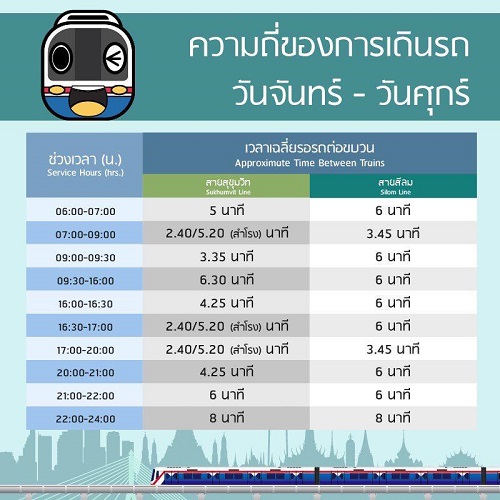
Bangkok BTS frequency on weekends and holidays is detailed below.

Bangkok BTS Fare 2024
The price of Single Journey Ticket, which is valid for a single journey on Bangkok BTS, depends on the length of journey as Bangkok BTS fare can be from 17 THB to 62 THB per journey.
The exact fare for your journey can be calculated on the interactive Bangkok BTS Map .
Bangkok BTS tickets
Below you will find detailed information about different types of Bangkok BTS tickets , where to buy them, how to pay for BTS in Bangkok and how to use the tickets.
Where to buy BTS ticket?
There are few ways to buy Bangkok BTS ticket but the most common way is using Ticket Issuing Machines. You will need cash to make a payment as credit/debit cards are not accepted.

While some of these machines are capable to take payments by notes, most of them (like the one below) still accept coins only.

For getting a ticket from these coin-only machines you need 1, 2, 5 or 10 Baht coins (satangs are not accepted). If you don’t have enough coins, you can change your notes at BTS Station Ticket Office.

There are also machines accepting notes but they can be harder to find. These ticketing machines accept not only 1, 2, 5 or 10 Baht coins (satangs are not accepted) but also 20, 50, 100 Baht banknotes (larger banknotes are not accepted).

Making a payment by QR code is also an option for travelers who have Thai bank account and Mobile Banking application.
How to pay for BTS Bangkok?
On the touchscreen of the Ticket Issuing Machine, choose your destination and a number of cards. Total fare of your trip will show up.

Insert coins and/or notes (if the machine accepts them) into dedicated slots. When the amount inserted will reach the required fare, your ticket (thin plastic card) will appear at the ticket-dispensing slot. Take the ticket and your change if any.

Keep in mind that Single Journey Tickets are valid for travel on date of purchase only !
Travel SMART! Get BTS One Day Pass if you are planning to use BTS often
It is also possible to purchase a Rabbit card that can be topped up and used for traveling with Bangkok BTS. Rabbit card can be bought at any BTS Station Ticket Office. Rabbit card can also be booked online and conveniently picked up at the airport. Rabbit card can be booked online here: BTS Skytrain Rabbit Card .
How to use BTS ticket?
When you get your Bangkok BTS ticket , proceed to the metallic gates. Green arrow signs indicate entry points - you need to choose one of them.

Touch your ticket at the marked spot on top of the metallic part of the gates and wait for the gate to open then. Take your ticket and quickly walk through as the gates stay open for just a couple of seconds.
Keep your ticket with you as at the exit you will have to insert it into the slot at the front of the metallic gate.

If you are using BTS One-Day Pass or BTS Rabbit Card, you need to tap the card at the dedicated place on top of the gate.
Then the gate will open for you to exit.
How to use BTS Bangkok SkyTrain
When you enter the Paid Area of Bangkok BTS station, you need to choose the platform. The platforms are named with the last station of the line and you just need to choose correct direction. Check the map at the station to make sure. Bangkok BTS Sukhumvit and Silom lines connect at Siam station and you might need to change the train and platform there.
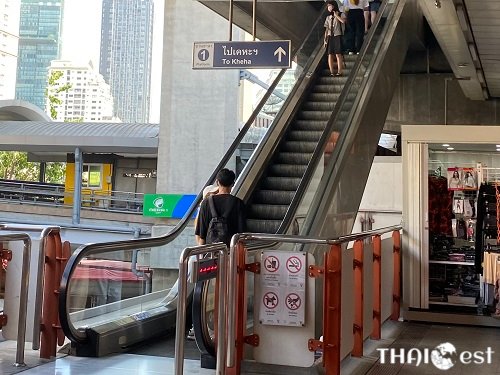
When you will get to the platform, you will notice that SkyTrain platforms have yellow arrows in black background pointing towards the track and black arrows in yellow background pointing from the track. You should wait in a line behind the yellow arrows in black background. The doors of the train will stop directly in front of the black arrows in yellow background and passengers will disembark the train there.

There’s a map inside the train showing your location and other stations on the line. The name of the next station is clearly announced in advance so you have time to prepare for disembarking the train.

If you will choose wrong direction or miss your station, don’t worry and just swap platforms at the next station. You don’t need to buy a new ticket if you just change platforms and don’t leave the Paid Zone.
Tips for Bangkok BTS
Bangkok BTS SkyTrain is very convenient when used with other Bangkok’s Mass Transit Systems such as MRT and Airport Rail Link. Connections between systems are the following:
BTS Sukhumvit Line connects with MRT Blue Line at BTS Asoke, BTS Mo Chit and BTS Ha Yaek Lat Phrao stations
BTS Silom Line connects with MRT Blue Line at BTS Sala Daeng and BTS Bang Wa stations
BTS Sukhumvit Line connects with Airport Rail Link at BTS Phaya Thai station
BTS Sukhumvit Line connects with MRT Yellow Line at BTS Samrong station
BTS Sukhumvit Line connects with MRT Pink Line at BTS Wat Phra Sri Mahathat station
BTS Silom Line connects with Gold Line at BTS Krung Thon Buri station
To save time that you normally would waste at ticket vending machines, consider getting BTS SkyTrain Rabbit Card that can be topped up instead of buying single journey tickets each time. It can also be used on MRT Yellow Line and Gold Line. Rabbit card can be booked online here: BTS Skytrain Rabbit Card .
To save money on the days when you are planning to travel by BTS a lot, get BTS SkyTrain One-Day Pass that will allow you to use BTS SkyTrain all day long for a fixed price. For saving even more, get your discounted ticket online here: BTS One Day Pass .
Where to Stay in Bangkok?
What is the best area to stay in Bangkok ? You should choose one of the areas well connected with BTS as it can really save your time. Our recommendations for choosing the right area to stay in Bangkok can be found here: Where to Stay in Bangkok .
Any Questions?
Check our Frequently Asked Questions about public transportation in Bangkok and ask your own question if it's not answered there yet.
FAQ – Bangkok Public Transport
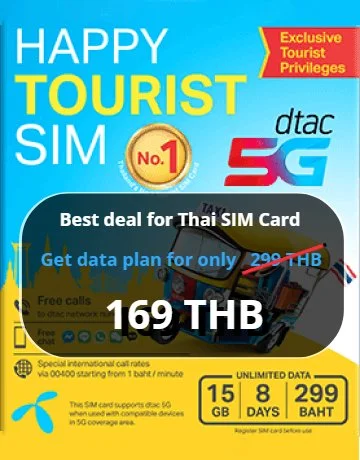
Popular on THAIest
Muay Thai Fights in Bangkok
Bangkok Hotels with Infinity Pools
Bangkok River Cruises
Full Moon Party Koh Phangan
Half Moon Party Koh Phangan
Koh Phangan Luxury Hotels & Resorts
Best Hotels in Chiang Mai Old City
Best Hotels in Ao Nang, Krabi
Phuket Pool Villas
We use cookies on our website. Some of them are essential for the operation of the site, while others help us to improve this site and the user experience (tracking cookies). You can decide for yourself whether you want to allow cookies or not. Please note that if you reject them, you may not be able to use all the functionalities of the site.
BTS Skytrain
The Bangkok BTS, or Skytrain, is an elevated rapid transit system in Bangkok, Thailand. It consists of two lines, the Sukhumvit Line and the Silom Line. The BTS provides convenient transportation across the city, serving as a reliable and efficient mode of travel for both locals and tourists. With air-conditioned trains and frequent service, the BTS offers a comfortable way to navigate through bustling areas, connecting key destinations such as business districts, shopping malls, and popular tourist attractions.
BTS Skytrain lines
The Silom Line is a vital part of Bangkok's BTS Skytrain system. Stretching 13 kilometers, it connects the western part of the city to the bustling Silom business district.
- G1 - Khrung Thon Buri
- G2 - Charoen Nakhon
- G3 - Khlong San
Sukhumvit line
The BTS Sukhumvit Line: Bangkok's vital transit route along Sukhumvit Road, connecting key areas, malls, and business districts.
Tickets and prices for BTS
Single journey.
17 - 62 Bath per journey
Time limit 2 hours
Buy at Ticket Issuing Machine
Price 150 Bath
Available at BTS Ticket Offices
Cards and payment
Most machines takes coins
Pay with QR ( Thai QR or Rabbit LINE)
Rabbit Card as electronic wallet
Map of BTS and MRT
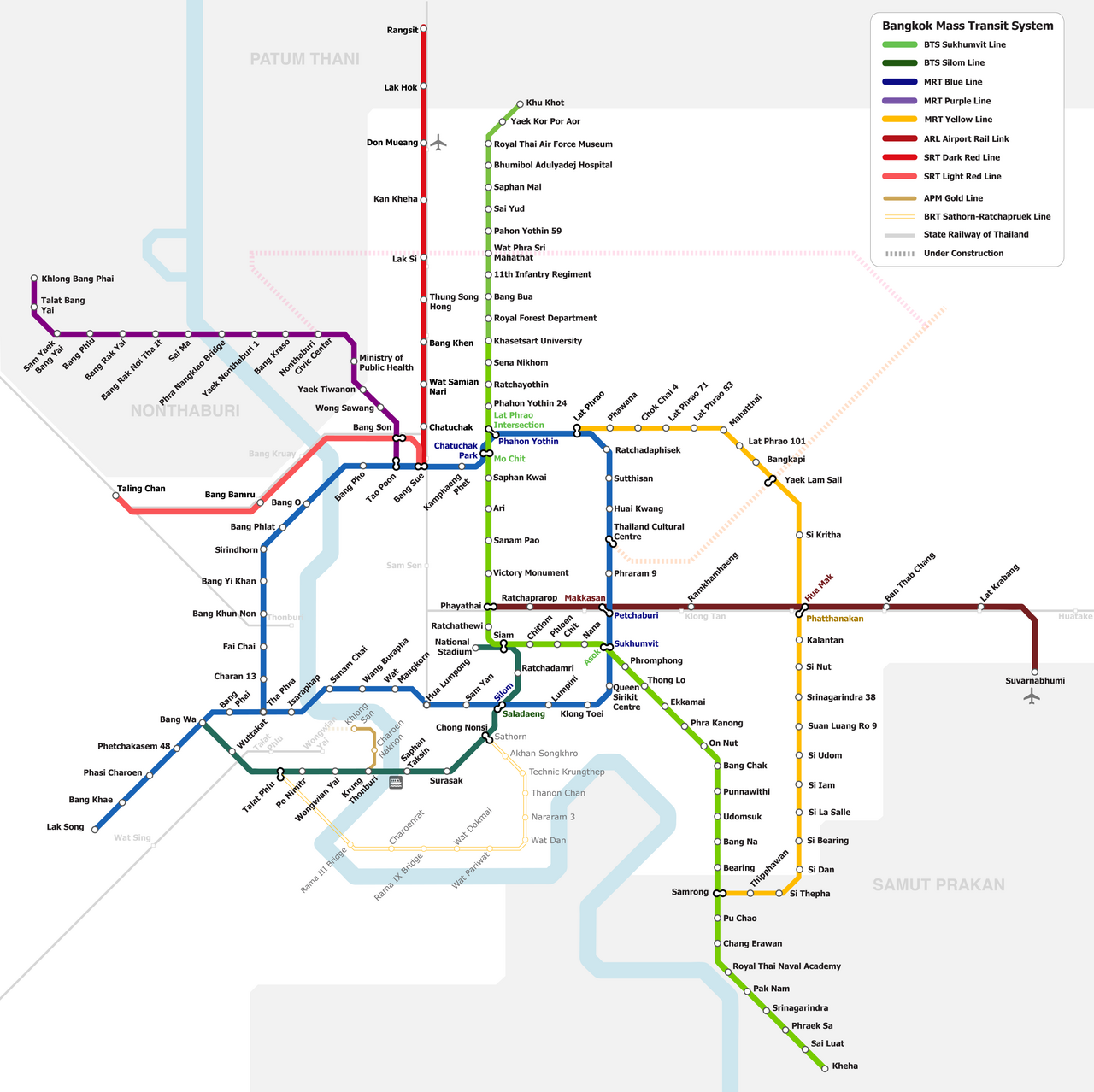
Jerikodaldatan 6, 595 30 Mjölby, Sweden
+46766519617
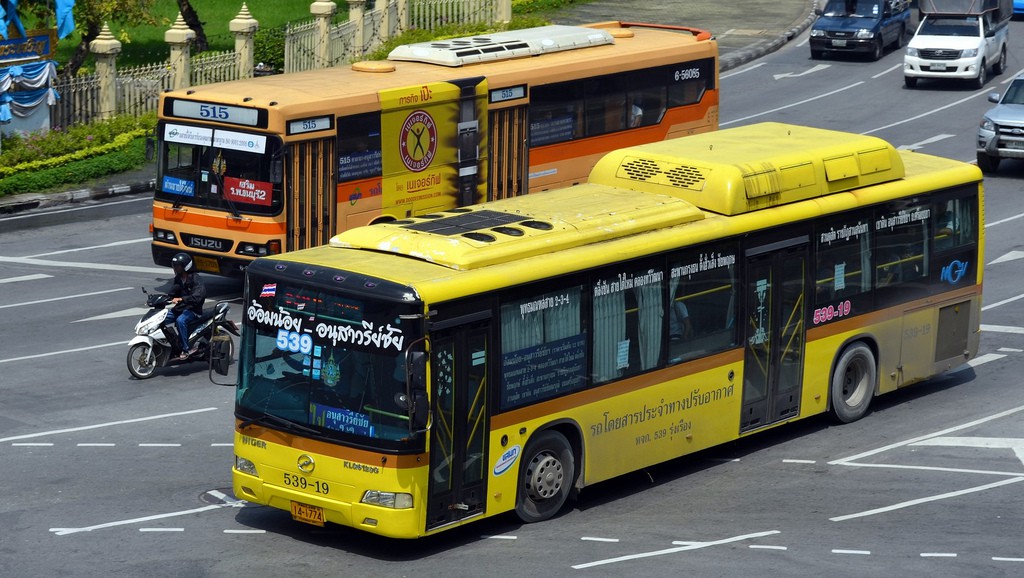
Sign up for our free newsletter
Price: 0 Bath

The Bangkok Skytrain (BTS) – A Tourist’s Guide
The Bangkok Mass Transit System, commonly known as the Skytrain or BTS, is the most efficient means of transportation in in Bangkok.
Since 1999 the BTS has been helping Bangkokians and tourists alike hop easily from one station to another
Aside from convenience and speed, fares are cheap compared to other transport modes, and of course fixed, so you won’t have to worry about being overcharged by a tuk tuk!
The Bangkok Skytrain runs on two lines comprising 44 stations.
The Sukhumvit line (light green) runs from Wat Phra Sri Mahathat to Kheha, while the Silom line (dark green) runs from the National Stadium to Bang Wa. These lines intersect at the central Siam BTS Station.
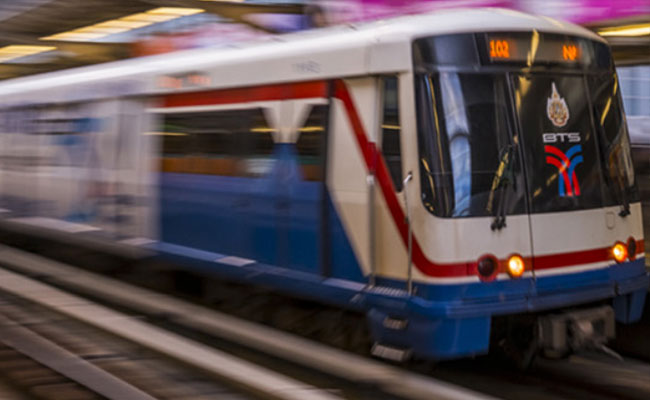
Service Hours
The Bangkok Skytrain operates daily from 6 AM to midnight.
Like every other city, the busiest times are the early morning and early evening, as commuters to and fro from work.
It is best to travel after 10 AM and before 4.30 PM, and then after 7.30 PM.
Key Destinations
The best thing about the Bangkok Skytrain from a tourist's perspective is that is that it enables you to visit different destinations much faster than taking a taxi.
Here's a list of noteworthy stations that will take you to some great places.
And if you want to see a big map, go here .
Asok station intersects with the underground line, the Mass Rapid Transit system (MRT).
This is the gateway to Sukhumvit and, as well as access to the Terminal 21 Mall, you can easily walk from here along to Soi Nana and the Thong Lor and Ekkamai areas.
For those wanting to visit Soi Cowboy, this is also the stop you need.
2. Mo Chit BTS
This station is your gateway to the biggest market in the city, the Chatuchak Weekend Market.
The market boasts over 15,000 shops, run by more than 11,000 stall owners.
The market draws huge crowds on Saturday and Sunday, but note that it's also open on Friday evening from 6 PM.
3. Victory Monument Station
Referred to locally as Anusawari Chai Samoraphum, Victory Monument sites in a highly urbanized neighbourhood with a great street market, fairly priced eateries and plenty of shops.
It is home to the famous Victory Monument landmark, erected in June 1941 to commemorate the Thai victory in the Franco-Thai War .
Victory Monument also boasts Santiphap Park (Park of Peace). This gem of a park is beautifully kept and deserving of a chill-out by the lake.
My advice is to head to the park around 5pm, hang out there until the sun starts to go down, then go for dinner at a local restaurant, and then browse the market. You can even walk into Sukhumvit from Victory Monument afterwards to grab a few drinks.
4. Siam Station
Because Bangkok Skytrain’s Sukhumvit and Silom lines first intersect at this station, Siam BTS Station is regarded as the central BTS station.
This is a big shopping district. Here you'll find the famous Siam Paragon, Siam Square, Paragon Cineplex and lots more shops!
5. Ari Station
Not far from Mo Chit BTS Station is Ari, a popular expat area next to the famed La Villa – a luxury-inspired mall that features designer shops and alfresco restaurants.
La Villa, which is open from 10 AM to 10 PM. La Villa is a conceptual mall, combining green space with modern architecture.
It houses an upscale supermarket, banks, service centres and a number of trendy cafés and restaurants to serve neighbouring residents and office workers.
6. Saphan Taksin Station
Saphan Taksin is the station your need for the Bangkok National Museum, and also a way to get to the Grand Palace , holy Temple of the Emerald Buddha, and the Temple of the Reclining Buddha – simply known as Wat Pho.
For the latter, you can alight at Saphan Taksin for the Tha Maharaj Pier.
You can then take the Chao Phraya Express boat down the river of the same name and visit these historic places.
Taking the boat is a great way to see how people live next to the shallows of this famous river.
TIP: Be careful of water drops splashing up into your mouth and eyes. You don't want dysentery.
7. Sala Daeng Station
Sala Daeng station is the closest to the Patpong entertainment district. There's also a popular night market here.
It's not somewhere you'll want to take the kids, though, certainly not after 7 or 8pm.
Patpong is a red light district and famed for kick-starting the go-go culture in Thailand's tourist districts.
The red light area is made up of two parallel streets with the night market in the middle.
There are over 20 go-go bars, as well as the infamous sex and ping-pong shows.
I don't advise going to these shows, as certain shows are famed for scamming tourists with big bar bills.
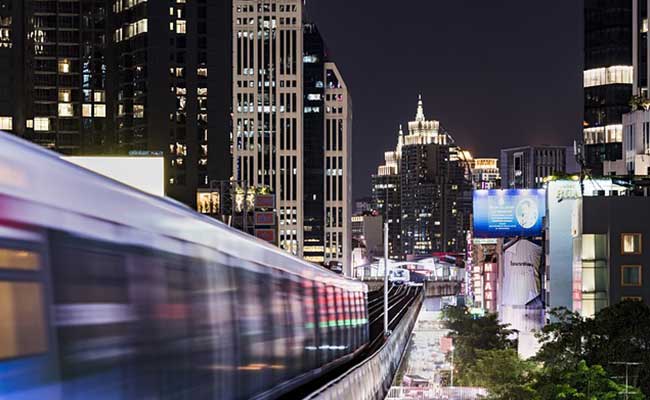
Cost & Purchase
The minimum price on the BTS Skytrain is 16 Baht for a single journey.
The price obviously increases in relation to the length of your journey, and goes up to 59 Baht for the longest journey.
There are no return journey tickets; you simply buy one on the way back, or buy for a return journey at the same time.
You can pay at a machine or use the cashier desks. A few stations have ticket machines that accept bank notes, but most only accept 1, 5 and 10 Baht coins.
If you're unsure, just queue for the cashier; they are always very helpful.
The amount you'll need to pay is detailed at the machine and on signs; it's all really straightforward.
Other Ticket Options
If you plan to roam around Bangkok and visit multiple destinations, then get a day pass – priced at 140 Baht.
If you plan to stay in Bangkok for a while, the BTS Skytrain Rabbit Card will be your best bet.
It is a reloadable card that you can tap on the turnstiles during entrance and exit.
Rates are calculated according to the station you exit, and the amount is deducted from the card.
Aside from being used to pay for fare, the Rabbit Card can be used as an electronic payment method when purchasing goods in some local shops and selected convenience stores.
The Rabbit Card has three types so take note of the type you can avail to get a discount.
- The student card can be availed by any local or foreign student who is 23 years old and can show proof of identity as a student.
- The adult card suits local or foreign passengers and is priced at 200 Baht. The amount covers a service fee of 100 Baht, and the rest is stored as a usable amount. As a tourist, you can have the service fee refunded if you return the Rabbit Card before you leave Bangkok.
- The senior card is exclusive to Thai nationals who are at least 60 years old.
Connecting to Other Destinations
Bangkok mass rapid transit (mrt).
The BTS Skytrain intersects at certain stations where the Bangkok Mass Rapid Transit (MRT) operates.
Currently, some MRT lines are under construction, while the existing ones operate daily from 6 AM to midnight.
The lines are marked as blue and purple, and passengers can transfer from the MRT to the BTS Skytrain at specific stations, namely:
- Sukhumvit MRT Station/Asok BTS Station
- Silom MRT Station/Sala Daeng BTS Station
- Chatuchak Park MRT Station/Mo Chit BTS Station
- Phahon Yothin MRT Station/Ha Yaek Lat Phrao BTS Station
Tickets used on the MRT are in the form of tokens for a single trip, while cards similar to the Rabbit Card are used for multiple trips.
Just like the BTS, the minimum fare is priced at 16 Baht and increases based on the distance of the destination.
You cannot use MRT tickets for the BTS, and vice versa, so you'll have to purchase a new ticket every time you transfer.
Airport Rail Link
If you’re looking for a BTS route headed to the Airport Rail Link, use the BTS Sukhumvit Line and alight at Phaya Thai BTS Station.
If you’re departing from the Airport Rail Link, join the MRT by getting off at Makkasan Station, exit 2.
Once you have exited, proceed to the Phetchaburi MRT Station using the skywalk that connects the stations. Transfer takes around 8 minutes.
Bangkok Taxis
Upon exiting any BTS station, you'll find yellow or pink taxis hanging around or driving past.
Taking taxis centrally in peak times can be a traffic nightmare, so avoid them where you can.
Make sure that the driver’s meter is running before you start your journey; some taxis try it on and charge foreigners fixed fares – this mostly happens in the tourist areas.
Boat Rides – Chao Phraya Express Boat
As mentioned previously, you can connect to boats on the river by going to Saphan Taksin station.
This boat line is an affordable means of seeing the views along the Chao Phraya River.
Current prices range from 10 Baht for the local line service within one zone, up to 32 Baht for a green thru yellow flag trip on its entire route from Pakkret to Sathon), depending on the type of boat and the distance travelled
Here's a rundown of the different boat services that fall under the Chao Phraya Express Boat service:
This is a local boat service that only operates on weekdays. It stops at every pier and costs 9-13 Baht.
2. Blue Flag
This service is marketed at tourists. It operates each day of the week and stops at nine piers. Each trip will cost you 40 Baht, but you can save more when purchasing the all-day pass, which is priced at 150 Baht.
3. Yellow Flag
This boat service operates on weekdays and is normally used by local commuters. There are 10 pier stops and the rate per trip is around 20-29 Baht.
4. Orange Flag
This boat is available daily and takes the route between Nonthaburi and Wat Rajsingkorn. Only the main piers are used as stopping points, with each trip priced at 15 Baht.
5. Green Flag
Just like the No Flag service, Green operates on weekdays and is mainly used by locals. As an express boat service, this is an ideal boat to take when travelling to the beautiful island of Ko Kret. Rates per trip normally fall around 13 to 32 Baht.
River Ferries
A total of 32 ferry crossings are available along the Chao Phraya River and in some locations in the provinces of Nonthaburi and Samut Prakan.
With cheap rates as low as 3 Baht, you can cross the river with ease.
These river ferries can be found at Sathorn Central Pier, and are connected to the BTS Skytrain through Saphan Taksin Station.
Long Tail Boats
These boats are found at Sathorn Central Pier and can be hired for private use.
If you are in a group, this is a good option for private sightseeing.
Normally offered by private tour companies, the price of long tail boat hire is usually negotiable and dependent on the number of passengers and distance of the journey.
Canal Boats
Locally known as the Saen Saep Boat Service, these boats are docked in the pier near Ratchathewi BTS Station.
Operating hours on weekdays are between 5:30 AM and 8:30 PM, and until 7 PM on weekends. Ticket rates vary but normally cost 8-20 Baht per trip, depending on the distance.
Shuttle Boats
Shuttle boats are located in the Sathorn Central Pier adjacent to Saphan Taksin BTS station. Some of the better hotels in the area offer free rides to guests.
The BTS Skytrain in Bangkok is the best way to get around town.
It is air conditioned, which is very welcome after stepping off a 32 Celsius sidewalk.
Unlike the Tube system in London, the BTS is clean and people are generally very respectful to each other.
Don't forget the seat etiquette in Thailand. Monks get priority on seats, followed by the elderly, pregnant women and children; so be prepared to give your seat up to any one of these people if they are standing.
The MRT (the underground) is equally good. It's easy to connect to the BTS and intersects at key stations like Siam and Asok.
As a rule of thumb, try to stay within 6 stops of Asok or Siam station. That way it will be quick and easy for you to get into the centre of town.
GET MY NEWSLETTER
Join thousands of others who receive my monthly roundup of content & insider tips on how to survive & thrive in Thailand.
Last Updated on November 6, 2020
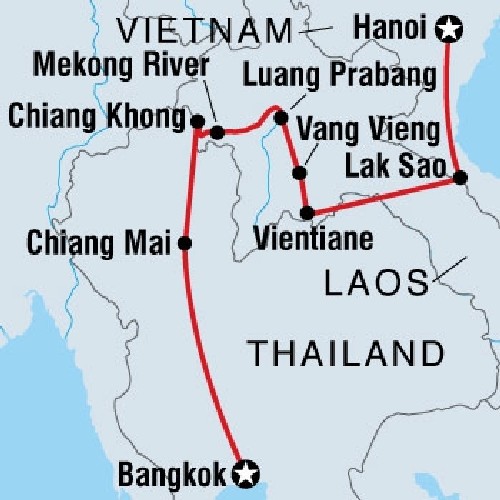
Comments Sort by : newest | oldest
Barbara says
January 25, 2024 at 12:53 am
Jan 25, 2024 at 12:53 am
TheThailandLife says
January 25, 2024 at 9:06 pm
Jan 25, 2024 at 9:06 pm
December 12, 2022 at 1:02 am
Dec 12, 2022 at 1:02 am
December 12, 2022 at 4:25 am
Dec 12, 2022 at 4:25 am
JamesE says
December 12, 2022 at 4:46 am
Dec 12, 2022 at 4:46 am
February 4, 2024 at 8:33 pm
Feb 04, 2024 at 8:33 pm
March 1, 2021 at 8:54 pm
Mar 01, 2021 at 8:54 pm
James E says
June 26, 2020 at 8:07 am
Jun 26, 2020 at 8:07 am
March 1, 2021 at 8:20 am
Mar 01, 2021 at 8:20 am
March 1, 2021 at 5:36 pm
Mar 01, 2021 at 5:36 pm
Leave a Reply Cancel reply
Your email address will not be published. Required fields are marked *
Notify me when new comments are added.
- A Guide To Using The...
A Guide to Using Bangkok's BTS Skytrain

In traffic-choked Bangkok , the BTS Skytrain is a godsend. Its two lines – there are more on the horizon – make zipping around the Thai capital a breeze. That’s assuming you know how to use the system, so for a Bangkok travel, here’s your guide to just that.
Did you know you can now travel with Culture Trip? Book now and join one of our premium small-group tours to discover the world like never before.
Launched in 1999, the BTS Skytrain is one of the most popular ways to get around Bangkok. From its icy-cold air-conditioned carriages running on elevated tracks through much of downtown Bangkok, you can escape stationary traffic, taxi drivers demanding inflated fares, and the expansive (but difficult-to-navigate) bus network. Using the Skytrain is easy once you know the basics, so arm yourself with this helpful guide and you’ll be good to go.
Want to sit back and let someone else take care of the planning for you? Our 10-day Northern Thailand trip takes you to the best destinations in the north of the country – with the help of our Local Insider.
Where does the Skytrain go?
Although geographically it only covers a tiny portion of the huge metropolis that is Bangkok, the Skytrain’s two lines – known as the Sukhumvit and Silom lines, after the major roads they mostly run along – cover the most frequented parts of the city.
Both lines have been heavily extended since they first opened, with further extensions planned. Additional Skytrain, MRT subway, monorail and Airport Rail Link routes are all in the pipeline, meaning Bangkok’s public transport infrastructure should have as many as 13 different lines by 2029.
For now, the BTS’ Sukhumvit line runs from Mo Chit (alongside Chatuchak Park and its weekend market) in northern Bangkok all the way to Samrong, just across the border in Samut Prakan province to the east of the capital.
Meanwhile, the Silom line takes you from the National Stadium in downtown Bangkok, through the Silom and Sathorn business and nightlife districts, and out to suburban Bang Wa to the south. The only point at which the two lines connect is at the central Siam interchange station.

How much do tickets cost?
The BTS is one of Asia’s most expensive public transport networks, but it can still seem excellent value to those visiting from elsewhere (particularly Europe and North America). Fares are adjusted every year or so – usually heading up rather than down. Right now, riding the Skytrain costs from 16 Thai baht (£0.37) for a single ticket to travel one station, up to 59 baht (£1.38) to take in the whole system. A one-day ticket for unlimited travel costs 140 baht (£3.26).
Children under 90cm in height travel free, while kids taller than this must pay the full fare (there are height charts around the ticket machines). If using a Rabbit card (see below), there are discounts available for students at Thai universities and for the elderly. However, unlike the MRT subway, the BTS only grants Thai citizens the elderly discount – even retired expats in Thailand are not eligible.

Using a pre-paid Rabbit card
Here is one of the best Bangkok travel tips – to save time queuing, you can obtain a stored-value Rabbit card for a 100 baht (£2.33) deposit. You can then load it with cash to pay as you go (each trip is one baht, or £0.02, cheaper if you do this) or buy a set number of pre-paid trips, valid for 30 days, at a discounted rate.
But this is where the BTS gets complicated. A private company operates the bulk of the Skytrain network (from Mo Chit to On Nut on the Sukhumvit line, and from National Stadium to Wongwian Yai on the Silom line) under a franchise agreement. Meanwhile, Bangkok’s city government runs the remaining sections (from Bang Chak to Samrong on the Sukhumvit line, and from Pho Nimit to Bang Wa on the Silom line).
The two don’t work all that seamlessly on fare collection, so Rabbit card users with pre-paid trips can only travel on the main section – if you want to use the other stations, you’ll also need to add cash to your Rabbit card, which will be charged an additional flat fare of 15 baht (£0.35) for each journey.
Sounds unnecessarily convoluted? That’s because it is. The good news, however, is that this doesn’t affect short-term visitors just buying single or one-day tickets – those fares are all-inclusive. (Technically the maximum single cash fare is 44 baht, or £1.02, and if you’re going to one of the far-flung stations there’s a 15 baht surcharge, which is built into the total 59 baht fare).

How do you buy a ticket?
Single tickets are only sold by machines, and not at the staffed ticket booths. Most of the older machines only accept coins (and some can’t handle two-baht coins), but a few larger, newer machines also take notes.
If you don’t have coins, staff at the ticket booths can provide change – they also sell one-day tickets and can set you up with a Rabbit card. Note that debit and credit cards are only accepted if you’re adding trips to a Rabbit card, not just stored value.
To use the older ticket machines, simply consult the map alongside to check the fare for your destination, and push the button for that amount on the machine. Then insert your coins into the slot, and your ticket will pop out. Collect that and any change, and you’re ready to insert your ticket into one of the station’s automatic entry gates (there’s a small arrow on the ticket to show you the correct way to push it in).
Newer ticket machines work in a similar way, except that you select your destination on the touch screen. Rabbit card users need to do nothing more than touch their card on the reader on the entry gate.

What else to know about Bangkok’s BTS Skytrain
The BTS doesn’t run quite as late as trains in other cities, so know when your last one of the night is leaving. Each station’s first and last train times are posted at the ticket booths.
As a guide, the first train leaves each end of the Sukhumvit line at 5.15am, and on the Silom line at 5.30am. The last Sukhumvit line train leaves Samrong towards Mo Chit at exactly midnight, and in the opposite direction leaves Mo Chit towards Samrong at 12.12am.
The last Silom line train leaves Bang Wa towards National Stadium at midnight; going the other way, it leaves National Stadium towards Bang Na at 12.24am. If you are using both lines and taking the last train, you’ll need to allow time to interchange at Siam.
No food or drink is allowed inside the stations (just in case you wondered why the trains are so clean!), and a guard at the entrance might carry out a cursory security check of your bag. Oh, and stay behind the yellow line on the platform – the guards have whistles and aren’t afraid to use them.
Best BTS stations for markets
Chatuchak weekend market is the mother of all Bangkok shopping experiences, and it’s located right beside Mo Chit station. Head to Sala Daeng station for Patpong night market, or take a taxi from Udom Suk station for vintage-themed Talat Rot Fai night market.

Best BTS stations for shopping malls
Bangkok has no shortage of high-end shopping malls , and most are conveniently located for the Skytrain. Siam station is right beside Siam Paragon and Siam Center, while National Stadium is connected to bargain-friendly MBK.
Chit Lom station is linked to Central Chidlom, and it’s a short walk from enormous Central World. Take the BTS to Phloen Chit for ultra-luxe Central Embassy, to Asok for airport-themed Terminal 21, and to Phrom Phong for sister malls EmQuartier and Emporium.
Best BTS stations for food
Great Thai food is everywhere around Bangkok . But for some of the best, change at Asok, Mo Chit or Sala Daeng stations and take the MRT subway to Hualamphong station for Chinatown. Alternatively, see below for heading to old-town Banglamphu, packed with long-running street food shops.
Best BTS stations for the old town
New MRT subway stations are on the way in traveller-friendly old-town Bangkok, but for now it’s off the BTS grid. To get there, take the Skytrain to Saphan Taksin and then hop on the Chao Phraya Express boat (the orange-flagged boats are cheap and convenient) to Phra Athit.
Or ride the BTS to Ratchathewi, from where you can walk to the Pratunam pier and take the Saen Saeb canal boat to Phan Fa Lilat (a 13-minute walk from Khao San Road) – or simply take a taxi from BTS Ratchathewi.
Best BTS stops for nightlife
For Sukhumvit Soi 11’s popular strip of restaurants, bars and clubs, alight at Nana station (the Nana red-light district is also across the road). Thong Lo station will put you within walking distance of the kind of nightlife that attracts trendy, high-flying Bangkokians and expats alike.
Sala Daeng station is home to Bangkok’s other red-light district around Patpong, as well as the mainly foreigner-favoured gay district on Silom Soi 2 and Soi 4. Just a couple of stations along the line, get off at Chong Nonsi for the stylish and sophisticated bars and restaurants of Sathorn.
Connecting with Bangkok’s other public transport
Interchange between the Skytrain’s Sukhumvit and Silom lines at Siam – you may need to take the escalator up or down to change trains.
The BTS connects with the MRT subway at Asok, Mo Chit and Sala Daeng stations, and with the BRT express bus service at Chong Nonsi.
Change for the Chao Phraya Express river boat service at Saphan Taksin, and for the Saen Saeb canal boat at Ratchathewi (and elsewhere). If you’re taking a mainline train elsewhere in Thailand, change to the MRT subway and then travel to Hualamphong station.
Suvarnabhumi airport can be reached by Airport Rail Link from BTS Phaya Thai, and Don Muang airport is connected by a special bus route from Mo Chit station.
Since you are here, we would like to share our vision for the future of travel - and the direction Culture Trip is moving in.
Culture Trip launched in 2011 with a simple yet passionate mission: to inspire people to go beyond their boundaries and experience what makes a place, its people and its culture special and meaningful — and this is still in our DNA today. We are proud that, for more than a decade, millions like you have trusted our award-winning recommendations by people who deeply understand what makes certain places and communities so special.
Increasingly we believe the world needs more meaningful, real-life connections between curious travellers keen to explore the world in a more responsible way. That is why we have intensively curated a collection of premium small-group trips as an invitation to meet and connect with new, like-minded people for once-in-a-lifetime experiences in three categories: Culture Trips, Rail Trips and Private Trips. Our Trips are suitable for both solo travelers, couples and friends who want to explore the world together.
Culture Trips are deeply immersive 5 to 16 days itineraries, that combine authentic local experiences, exciting activities and 4-5* accommodation to look forward to at the end of each day. Our Rail Trips are our most planet-friendly itineraries that invite you to take the scenic route, relax whilst getting under the skin of a destination. Our Private Trips are fully tailored itineraries, curated by our Travel Experts specifically for you, your friends or your family.
We know that many of you worry about the environmental impact of travel and are looking for ways of expanding horizons in ways that do minimal harm - and may even bring benefits. We are committed to go as far as possible in curating our trips with care for the planet. That is why all of our trips are flightless in destination, fully carbon offset - and we have ambitious plans to be net zero in the very near future.

Guides & Tips
Top tips for travelling in thailand.

The Best Private Trips to Book for a Relaxing Retreat

See & Do
The solo traveller’s guide to northern thailand.

The Best Long Trips to Take in 2024

A Guide to Sailing in Thailand

The Best Tours for Visiting Multiple Countries in One Trip

The Best Two-Week Itineraries Around the World

The Best Places to Travel in 2024

How Much Does a Trip to Thailand Cost?

The Best Trips and Tours in Thailand

Restaurants
The best waterside restaurants in thailand.

The Best Private Trips to Book in Thailand
Culture trip spring sale, save up to $1,100 on our unique small-group trips limited spots..

- Post ID: 784178
- Sponsored? No
- View Payload
How You Can Navigate Bangkok's BTS Skytrain Like a Pro
BY Pelago by Singapore Airlines
14 SEP 23 . 4 MIN READ . GUIDES
Bangkok's BTS Skytrain Guide - Forget Traffic Woes
Picture this: There are at least 100 flashing street lights and neon signboards lining the roads; hordes of people crowding vendors; some trying to cross the street, attempting to find their way through choc-a-block traffic; AND, it’s the first day of your holiday in Bangkok! Praying for a quick solution? Well, the BTS Skytrain is heaven-sent for you , so you can worry less about transport and enjoy Bangkok more. But hang on. To be able to do that, you must know how to use this system. You’ve hit the right page; because we have your back. Here’s every must-know detail about Bangkok’s BTS Skytrain that you need to travel like an expert.
- What is Bangkok’s BTS Skytrain?
- BTS Skytrain vs. MRT
- What are the operating routes?
- How to efficiently use the BTS?
- How to buy Skytrain tickets?
- What’s a Rabbit Card?
- What are the most frequently used stations?
- Tips you can’t (and shouldn’t) ignore
What is Bangkok's BTS Skytrain?
It would be safe to call the BTS Skytrain the lifeline of the Thai capital, which has been the case since 1999. One of Southeast Asia’s most advanced public transport systems, this sophisticated monorail connects the top spots in the city, making the commute easy even for first-time travellers. It may only cover a bit of Bangkok’s ginormous metropolis, but the train runs through the most-frequented and important parts of the city. How? The answer is in the name – ‘sky’ train. It operates at an elevated level, about 30-33 feet above the ground.
BTS Skytrain vs MRT

You’d ask, what’s the difference between the BTS and MRT? Which one’s better? Here’s a quick comparison; just take note that you might need to use both the BTS and MRT depending on your journey.
Coverage : The BTS Skytrain covers a larger area of Bangkok compared to the MRT. Especially popular areas like Sukhumvit Road, Silom Road, and Siam Square. This makes travel easy for tourists.
Reliability : The BTS frequency of trains is way more regularn compared to the MRT. Moreover, BTS is known for its punctuality.
Connections : You’ll get better connectivity with other transport modes with BTS Skytrain. For instance, the Airport Rail Link and the Chao Phraya River Express Boat.
The view : Because it takes a route high above the ground, the BTS Skytrain offers unmissable views of the bustling city.
What are the operating routes of the BTS Skytrain?

Image source
Sixty-one stations are conveniently spaced on two lines – Silom and Sukhumvit. They intersect at Siam Central Station, where you can transfer anywhere on the network. The Sukhumvit line operates from Mo Chit in north Bangkok to Samrong in Samut Prakan province in the east, passing along the famous Chatuchak Park weekend market.
The Silom line goes from central Bangkok’s National Stadium via the Silom and Sathorn areas, popular for their business and party scenes, to the south’s suburban Bang Wa. Don’t worry though; you’ll find maps easily available (in English as well as Thai) at the stations/tourist centres.
1. How to efficiently use the BTS?
Bangkok bts skytrain one-day pass.
Bangkok BTS Skytrain isn’t much different from trains in large cities. Even for first-timers in the city, it’s user-friendly, considering there are (at the moment) only two lines, and you won’t need to make more than one connection. What you must essentially do, though, is plan your route well in advance so you don’t waste your single-journey ticket. However, if you’re visiting only for a limited time, we’d suggest not spending too much time understanding routes.
How can you buy Skytrain tickets?
Vending machines (not staffed booths) at stations are the only way to purchase tickets. Do note that many older machines accept only coins, but newer, larger machines accept notes as well. They also sell one-day tickets and Rabbit cards, for which you can ask for assistance.
You’ll find the exact fare for your destination on the BTS map. Press the corresponding buttons on the machine and insert money. Your ticket will then be dispensed. While entering the station, insert your ticket into the entry gate.
What's a Rabbit Card?
The best way to save time standing in lines! All you need is a THB100 deposit, and you can load cash onto your Rabbit card for slightly cheaper prices for each trip. You can also purchase a set number of pre-paid trips (30-day validity) at a discounted rate.
Now here’s the confusing part. Most of the Skytrain network is operated by a private company, and the rest are government-operated. As you’d expect, these two networks don’t work seamlessly together while collecting fares. Therefore, pre-paid trips are practical only on one section of the network. For other stations, an additional THB15 is charged per journey. But, this doesn’t affect short-term visitors, who usually buy (the all-inclusive) single tickets or one-day passes, in which case, the max amount for a single trip is about THB44. If you’re going to a distant station, there’s a surcharge of THB15.
Which are the most-frequented stations?

Image Source
That depends on where each station takes you. Naturally, stations of the Skytrain that connect to the city’s best attractions are the most popular. Here’s a quick guide for you. (Of course, you explore places other than these).
*Make a note of the operating hours of BTS Skytrain, which is every day, from 6am until midnight.
Tips You Can't (and Shouldn't) Ignore
Whether you’re a seasoned traveller or a first-time visitor in Bangkok, these pointers will make your journey better.
Routes/Map: Familiarise yourself with the routes before you hop on the train. This will help you better plan your journey and make transferring between lines easier.
Scams : Buy your cards/passes ONLY from official websites. Seek help from tourist info points if you’re confused. Keep away from ticket-sellers or over-friendly strangers offering any help.
Rush Hours : If you can, plan your journeys outside of the office/peak hours to avoid crowds and have a comfortable ride. This is especially important if you’re carrying heavy luggage.
BTS Skytrain App : Download the official app to check train schedules and minimise waiting time.
Be Mindful : Watch your belongings while on the train/platform. Pickpockets are common in crowded areas, and it’s best to be vigilant
Food/Drinks : Do bear in mind that eating/drinking is strictly NOT allowed on the BTS Skytrain.
Courtesy : There are priority seating areas (for pregnant women, the elderly, and persons with disabilities). It goes without saying that (if you don’t fall into any of these categories) giving up your seat to those who need it more is always appreciated.
MOST Important : Utilise your BTS Skytrain pass/card to visit not just tourist attractions and malls; do explore backstreets and lanes, where you can experience the true charm of Bangkok’s authentic local culture.
Unleash your wanderlust with unlimited travel
The Skytrain is cost-effective. Agreed. But we all like the word ‘unlimited’, don’t we? With routes connecting top attractions, an unlimited BTS travel pass seems like a dream come true. Don’t worry…Pelago heard you! Armed with this pass, you can enjoy unlimited rides on the BTS Skytrain for an entire day. You get to access the best spots in the city, from tourist attractions to shopping malls. And, guess what? It doesn’t need any activation!
2. Pre-booking your BTS Skytrain tickets
Holiday 'maximiser'.
Just a few days in Bangkok make you realise that there’s hardly anything you can’t experience in this city. Historical sites, heritage landmarks, breathtaking views, stunning nature trails, unending options for foodies and shopaholics, luxury spas, adventure parks, skywalks…the list won’t end!
And just when the desire to check everything off your list overwhelms you, the BTS Skytrain comes to the rescue. Simply put, it makes travel in Bangkok easy enough to make your bucket list goals achievable. This convenient, accessible, cost-effective, and time-saving transport option ‘maximises’ your getaway and leaves you wanting for more.
Commonly Asked Questions
What’s the usual fare for the bts skytrain.
It depends on the distance travelled. The minimum range usually is around THB16-23.
What is the frequency of trains?
Trains usually arrive every three to five minutes during rush hours. At off-peak hours, the frequency might be around seven to ten minutes.
Are the announcements made in English?
All announcements and signs in the BTS Skytrain are in Thai and English.
Does it connect to the airport?
The BTS Skytrain doesn’t directly connect to Bangkok’s main airports. But you can choose other options like the Airport Rail Link.
I’m a solo traveller. Is the BTS Skytrain safe?
Yes! There are CCTV cameras throughout stations and trains, and security staff is present at multiple points.
You might also like
The ultimate guide to visiting the puffing billy steam train.
21 APR 24 . 4 MIN READ . GUIDES
A Guide to Exploring Singapore's Southern Islands Like a Pro
Sydney world pride 2023: the ultimate guide, 7 best hotel staycations in singapore to bliss out at.
21 APR 24 . 2 MIN READ . GUIDES
Public Transportation and Metro Rail Information

Bangkok Sky Train (BTS)
Bangkok sky train information.
The Bangkok Mass Transit System or BTS or Sky Train is a rapid transit system that serves Bangkok, Thailand. The system is an elevated system and began operations on 5 th December 1999, and presently has 2 lines which serve 34 stations. The system is owned by Bangkok Metropolitan Administration (BMA) Mass Rapid Transit Authority of Thailand and is operated by Bangkok Mass Transit System Public Company Limited. The total system length is 36.45 km (22.65 miles). Bangkok Sky Train along with Bangkok Metro constitutes popular means of public transportation in Bangkok. The Bangkok Mass Transit System has a daily ridership of 600,000 passengers.
Bangkok Sky Train Map
Map of Bangkok Sky Train System showing various lines and stations. Click on the map to enlarge it. You can also Download Bangkok Sky Train Map in PDF .

Bangkok Sky Train Hours
The BTS Sky Train starts operations at 6:00 am and runs until midnight.
Bangkok Sky Train Fares, Tickets and Cards
Riders can purchase Magnetic tickets or SmartPass for making fare payments. The fare system is distance based. There are two types of Magnetic tickets, single journey ticket and One Day Pass. The minimum adult fare for a single journey ticket starts from 15 Baht and the maximum fare is 42 Baht. These tickets are valid on the date of purchase and can be bought from Ticket Issuing Machine (TIM), Integrated Ticketing Machine (ITM) and from Ticket Vending Machines (TVM).Riders can purchase a One Day Pass which provides unlimited rides for one day. It can be purchased from the BTS ticket offices. The cost of the card is 140 Baht.
The SmartPass uses contactless smart card technology and has an electronic chip that stores data. A 30-Day SmartPass can be purchased for 15, 25, 40 and 50 trips. The trips are valid for 30 days after the first use, for unlimited travel distance for the number of specified trips. A 15 trip 30 day pass costs 345 Baht, while 25 trips, 40 trips and 50 trips 30 Day Pass costs 525, 760 and 900 Baht respectively. The cards should be used within 45 days from the issue date or after the trips have been last refilled. This pass is available for students as well. The student card can be used by fulltime students who are not over 23 years of age.
The BTS system introduced a new type of card called Rabbit Card in 2012. In addition to BTS, this card can also be used for fare payment on the BRT. This is a stored value card and has an initial issuing fee of 50 Baht.
Children with height less than 90 cm can ride the Sky Train for free.
For more information on fares, visit
http://www.bts.co.th/customer/ en/01-ticket-type.aspx
Bangkok Sky Train Parking
Park and ride facilities are available for passengers at BTS stations daily or monthly basis. There are more than 500 parking spaces available for BTS riders. The parking lot opens daily from 5.00am to 2.00 am. Free parking facilities are available for BTS passengers at Wave place and it operates from Saturday to Sunday, 6.00am to 10.00pm. You must get your parking ticket stamped at BTS Phloen chit station ticket office.
Bangkok Sky Train Schedule
Currently operating on 2 lines and serving 34 stations, the schedule for the BTS service is available at the official website, which is: http://www.bts.co.th/customer/en/pdf/ServiceTimetable.pdf
Bangkok Sky Train Rules and Tips
Pets are not allowed on Sky Train except Guide dogs accompanying disabled people. The BTS provides park and ride facility at the stations. Passengers with a valid ticket can stay in the system for not more than 120 minutes after which an overstay penalty is charged according to the maximum fare. Park and ride facility is provided at stations.
Bangkok Sky Train Lines
The BTS system has two lines, the first one Sukhumvit line running from northwards towards eastward and Silom line is the second line. At the time of opening, BTS served 23 stations on its two lines and both the lines interchanged at Siam station.
- Sukhumvit line – The line was opened in 1999 with a length of 22.25km. The line serves 22 stations and the sky train operates between Mo Chit and Bearing. 3 car trains run at an average speed of 35kph. The line gets connected with Silom line and runs northward direction. The line is planning further to get extended with 9 more stations. The construction of extended route will start by 2014 and schedules to get opened in 2018.
- Silom line – Silom line was opened in 1999 with a length of 8.7km. The line serves 11 stations and the sky train operates between national stadium and Talat Phlu. From the National Stadium, sky train runs eastward and then turns southward where it crosses the Chao Phraya River. The line was extended further for 5.3km with 4 more stations. There are 6 car shuttles to offer services to the passengers through Silom line.
Bangkok Sky Train Places to Visit
● The Grand Palace: The major architectural symbol of the Thai Royal Family, the Grand Palace is 150 years old. Not only was it the official residence of the king but also of all of his administrative subjects. It’s very well known around the world for the Temple of the Emerald Buddha which lies in one corner of the Grand Palace complex. Open between 8:30-15:30, one can reach there using the Silom Line and getting off at the Saphan Taksin Station. Get out from Exit No. 2 and take the Chao Phraya Express Boat to Ta Chang Pier. From there, it is walking distance. ● Vimanmek Mansion: Recognised as the world’s largest teak mansion, it was built by Lord Rama V in the year 1990. His residence for 5 years, the Vimanmek Mansion exhibits a collection of the royal carriages used during his time.It is open from Tuesday to Sunday, between 09:30-16:00, with the exception of official holidays. To reach there take the Sukhumvit Line and get off at Victory Monument Station. Get out from Exit No.3. Walk towards Rajavithee Road and from there you can take either a taxi or a bus. ● City Pillar Shrine: Erected as a founding mark of Bangkok, the City Pillar Shrine is considered the spiritual guardian of the city. It is open everyday between, 05:30-19:30. To get there follow the same route as when you travel to the Grand Palace, it is located on Maha Chai Road which is closeby. ● Snake Farm: The snake farm holds a variety of venomous snakes. The venom from these snakes is extracted to make anti-venom to help the people unlucky enough to get bitten by such venomous snakes. It is open from Monday to Friday, between 08:30-16:00. On Saturday, Sunday and official holidays it is open between 09:30-13:00. To reach there, use the Silom Line and get off at Sala Daeng Station. Get out from Exit No. 3, from there it’s walking distance. ● Wat Sraket Ratchaworamahawihan: Also know as the Golden Mount, it is one of the most iconic and historical places in Bangkok. People can enjoy a great view of the city from its 78 metre tall pagoda. However, majority of the visitors go to worship to Lord Buddha. It is open daily between 8:00-18:00. To reach there one can take the Silom Line and get off at Saphan Taksin Station. Get out from Exit No. 2. You must then take the Chao Phraya Express Boat to Ta Tien Pier and from there one can take a taxi to Mahachai intersection.

Save my name, email, and website in this browser for the next time I comment.
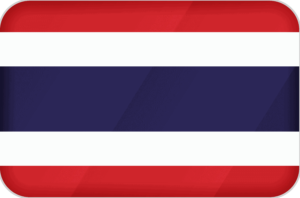
Search site
Bangkok mass transit system: a guide to the bts and mrt system.
Bangkok, the capital city of Thailand, is a bustling metropolis that attracts millions of tourists every year. With a population of over 10 million people, the city can be overwhelming to navigate, especially for first-time visitors. Fortunately, Bangkok has an efficient and extensive public transportation system known as the Bangkok Mass Transit System (BTS).
The BTS, also known as the Skytrain, is an elevated rapid transit system that covers most of the city’s central business district. The system has two lines – the Sukhumvit Line and the Silom Line – that intersect at Siam Station, making it easy to transfer between the two lines. The BTS is a popular mode of transportation for locals and tourists alike due to its speed, convenience, and affordability. It is also air-conditioned, making it a comfortable way to travel around the city, especially during the hot and humid months.
The BTS has become an integral part of Bangkok’s transportation infrastructure, connecting commuters to major shopping centers, tourist attractions, and residential areas. The system is operated by the Bangkok Mass Transit System Public Company Limited (BTSC) and has been in operation since 1999. In recent years, the BTS has undergone significant expansion, with new stations and lines being added to the network to improve connectivity and accessibility.
Bangkok Mass Transit System Overview
The Bangkok Mass Transit System, also known as the Bangkok Metro, is a rapid transit system in Bangkok, Thailand. It is operated by the Bangkok Mass Transit System Public Company Limited (BTSC), a subsidiary of the BTS Group Holdings. The system consists of two fully operational rapid transit lines and one monorail line in trial operation, with two more lines under construction.
The BTS Skytrain is an elevated rapid transit system that opened in 1999. It comprises two lines: the Sukhumvit Line and the Silom Line. The Sukhumvit Line runs from Mo Chit to Bearing, while the Silom Line runs from National Stadium to Bang Wa. The BTS Skytrain has a total of 34 stations and covers a distance of 55.5 kilometers.
The MRT, or the Metropolitan Rapid Transit, is a mass rapid transit system that began operations in 2004. It consists of two lines: the Blue Line and the Purple Line. The Blue Line runs from Hua Lamphong to Bang Sue, while the Purple Line runs from Tao Poon to Khlong Bang Phai. The MRT has a total of 48 stations and covers a distance of 67 kilometers.
The Bangkok Mass Transit System is a popular mode of transportation for locals and tourists alike. It is known for its cleanliness, safety, and efficiency. The system is fully integrated with other modes of transportation, such as buses and boats, making it easy to travel around Bangkok.
The fares for the Bangkok Mass Transit System are based on the distance traveled and range from 16 to 59 baht. There are also various types of tickets available, such as single journey tickets, stored value cards, and day passes. The system operates from 6:00 AM to midnight daily.
Overall, the Bangkok Mass Transit System is a reliable and convenient way to travel around Bangkok. With its extensive network and affordable fares, it is a popular choice for commuters and tourists alike.
BTS Skytrain
The Bangkok Mass Transit System, commonly known as the BTS Skytrain, is an elevated rapid transit system in Bangkok, Thailand. It is operated by the BTS Group Holdings, a subsidiary of the Bangkok Mass Transit Authority. The BTS Skytrain is one of the most efficient and convenient ways to get around Bangkok, especially during rush hour.
The BTS Skytrain has two lines: the Sukhumvit Line and the Silom Line. The Sukhumvit Line runs from Mo Chit to Samrong, passing through major areas such as Siam, National Stadium, Siam, Nana, Asok, Thong Lo, Ekkamai, and On Nut. The Silom Line runs from Bang Wa to National Stadium, passing through major areas such as Saphan Taksin and Sathorn.
The BTS Skytrain is known for its punctuality, cleanliness, and safety. It is also affordable, with tickets ranging from 15 to 59 baht depending on the distance traveled. Passengers can purchase single-trip tickets, stored-value cards, or one-day passes for unlimited travel.
The BTS Group Holdings is committed to continuously developing its system, operation, and personnel to provide a modern, fast, safe, efficient, and reliable service for its stakeholders and society. Procedures upon entering the BTS SkyTrain System with a bicycle are in place to ensure the safety of all passengers.
In conclusion, the BTS Skytrain is a convenient and reliable mode of transportation in Bangkok. With its efficient service and affordable fares, it is a popular choice for locals and tourists alike.
The Bangkok Mass Transit System (BTS) operates two fully operational rapid transit lines and one monorail line. The Mass Rapid Transit (MRT) system, on the other hand, operates two fully operational rapid transit lines, with a further two lines under construction.
The MRT Blue Line, also known as the Chaloem Ratchamongkhon Line, is the first line of the MRT system. It opened in 2004 and runs for 48 kilometers, with 38 stations. The line runs from Hua Lamphong in the South to Bang Sue in the North. It serves several important areas in Bangkok, including the Chatuchak Weekend Market, the Ratchadaphisek entertainment district, and the Thailand Cultural Centre.
The MRT Purple Line, also known as the Tao Poon–Khlong Bang Phai Line, is the second line of the MRT system. It opened in August 2016 and runs for 23 kilometers, with 16 stations. The line runs from Tao Poon in the North to Khlong Bang Phai in the West. It serves several suburban areas in Bangkok, including Bang Yai, Nonthaburi, and Bang Kruai.
The MRT system has two lines under construction: the MRT Yellow Line and the MRT Pink Line. The MRT Yellow Line, also known as the Lat Phrao–Samrong Line, will run for 30 kilometers, with 23 stations. It will connect Lat Phrao in the North to Samrong in the South. The line is expected to be completed in 2022.
The MRT Pink Line, also known as the Khae Rai–Min Buri Line, will run for 34 kilometers, with 30 stations. It will connect Khae Rai in the North to Min Buri in the East. The line is expected to be completed in 2027.
The MRT system also has two proposed lines: the MRT Orange Line and the MRT Brown Line. The MRT Orange Line, also known as the Taling Chan–Min Buri Line, will run for 35 kilometers, with 25 stations. It will connect Taling Chan in the West to Min Buri in the East. The line is expected to be completed in 2026.
The MRT Brown Line, also known as the Wongwian Yai–Rat Burana Line, will run for 13 kilometers, with 11 stations. It will connect Wongwian Yai in the West to Rat Burana in the South. The line is expected to be completed in 2025.
For a comprehensive map of the MRT system, please refer to the official Bangkok Metro Map .
Overall, the MRT system provides a convenient and efficient way for commuters and tourists to travel around Bangkok. With the ongoing expansion of the system, more areas in Bangkok will be accessible by public transportation.
SRT Red Lines
The SRT Red Lines is a commuter rail system that serves the Bangkok Metropolitan Region in Thailand. It is part of the Mass Rapid Transit Master Plan in the region. The construction of the Red Line began in January 2009, and free public trial operation began on August 2, 2021, with full commercial service to begin in November 2021 when Bang Sue Grand Station opens.
The SRT Red Lines is divided into two lines, the Dark Red Line and the Light Red Line. The Dark Red Line runs from Bang Sue to Rangsit, while the Light Red Line runs from Taling Chan to Rangsit. The two lines intersect at Bang Sue Grand Station, which is the largest railway station in Southeast Asia.
The SRT Red Lines is operated by the State Railway of Thailand (SRT), which is a state-owned enterprise responsible for the operation of Thailand’s railway system. The SRT Dark Red Line is operated by the SRT, while the SRT Light Red Line is operated by Bangkok Expressway and Metro Public Company Limited (BEM).
The SRT Red Lines is an important addition to the Bangkok Mass Transit System, which includes the BTS Skytrain, the MRT Subway, and the Airport Rail Link. The SRT Red Lines provides an efficient and affordable transportation option for commuters in the Bangkok Metropolitan Region.
Overall, the SRT Red Lines is a significant development in the Bangkok Mass Transit System, providing an important transportation option for commuters in the region.
Airport Rail Link
Bangkok’s Airport Rail Link (ARL) is a mass transit system that connects the city’s main airport, Suvarnabhumi Airport, with the city center. The ARL is an express and commuter rail line that covers a distance of 28 km and consists of eight stations. The line provides an airport rail link from Suvarnabhumi Airport, via Makkasan station, to Phaya Thai station in central Bangkok.
The ARL is the cheapest and easiest way to get to the city center from Suvarnabhumi Airport. The line is on a viaduct over the main eastern railway, which makes it faster than road transport. The ARL operates daily from 06:00 to 24:00, with commuter City Line trains departing every 10 minutes during peak hours (06:00-09:00 and 16:00-20:00) and 15 minutes off-peak.
The ARL has two lines: the City Line and the Express Line. The City Line stops at all stations, while the Express Line only stops at Makkasan Station and Suvarnabhumi Airport. The Express Line is faster than the City Line, but it is more expensive.
Passengers can purchase tickets from vending machines or ticket counters at the stations. The fare varies depending on the destination and the type of service. The City Line fare ranges from 15 to 45 baht, while the Express Line fare ranges from 45 to 150 baht.
The ARL is a convenient way to travel between Suvarnabhumi Airport and the city center. It is also connected to other mass transit systems in Bangkok, such as the BTS Skytrain and the MRT subway. The ARL is planning to extend the line to Don Mueang Airport in the future, which will provide an additional option for travelers.
Other Transit Lines
In addition to the BTS Skytrain and MRT lines, Bangkok’s Mass Transit System includes several other transit lines. These include the Airport Rail Link (ARL), the Bus Rapid Transit System (BRT), and the State Railway of Thailand (SRT) Red Lines.
The ARL is an elevated train line that connects the city center with Suvarnabhumi Airport. It has several stations along the way and is a popular choice for travelers looking to avoid Bangkok’s notorious traffic.
The BRT is a bus rapid transit system that operates on dedicated lanes and has several routes throughout the city. It is a cheaper alternative to the BTS and MRT lines, but can be slower due to traffic congestion.
The SRT Red Lines are partially elevated commuter rail lines that serve the Bangkok metropolitan area. There are currently two lines in operation, and several more are planned as part of the Mass Transit Master Plan.
Other transit lines currently under construction or in the planning stages include:
- The Gold Line: a people mover system that will connect Krung Thonburi BTS station with Khlong San district.
- The Purple Line: a monorail line that will connect Tao Poon BTS station with Nonthaburi province.
- The Yellow Line: a monorail line that will connect Lat Phrao BTS station with Samrong district.
- The Light Green Line: a monorail line that will connect Mo Chit BTS station with Saphan Mai district.
- The Dark Green Line: a monorail line that will connect Thong Lo BTS station with Suvarnabhumi Airport.
- The Orange Line: a mass rapid transit line that will connect Taling Chan district with Min Buri district.
- The Pink Line: a mass rapid transit line that will connect Khae Rai district with Min Buri district.
- The Grey Line: a mass rapid transit line that will connect Rama IX Road with Thonglor BTS station.
- The Light Blue Line: a mass rapid transit line that will connect Hua Lamphong Railway Station with Bang Khae district.
The Mass Transit Master Plan aims to create an integrated transportation system that will connect all parts of the city and reduce traffic congestion. With the addition of these new transit lines, Bangkok’s Mass Transit System is set to become one of the most extensive and efficient public transportation networks in the world.
Transit System Details
The Bangkok Mass Transit System (BTS) is a rapid transit system that serves the Bangkok Metropolitan Region in Thailand. The system consists of three lines with a combined route length of 70.05 kilometers (43.53 mi) and 62 stations. The BTS is operated by Bangkok Mass Transit System PCL (BTSC), a subsidiary of BTS Group Holdings, under a concession granted by the Bangkok Metropolitan Administration (BMA), which owns the lines.
The BTS operates on standard gauge tracks and is fully electrified. The system has a top speed of 80 km/h (50 mph) and carries a daily ridership of over 600,000 passengers. The fares for the BTS are distance-based and range from 15 to 59 baht. To make travel even more convenient, passengers can use the Rabbit Card, a debit card that can be used on the BTS, the MRT, and the Airport Rail Link.
Mo Chit Station is the northernmost station on the BTS Sukhumvit Line and is one of the busiest stations on the system. It serves as an interchange station with the MRT Chatuchak Station. Krung Thep Aphiwat Central Terminal is the southernmost station on the BTS Silom Line and serves as an interchange station with the MRT Hua Lamphong Station.
In conclusion, the BTS is an efficient and reliable rapid transit system that serves the Bangkok Metropolitan Region. With its distance-based fares, Rabbit Card, and convenient interchange stations, the BTS is a popular choice for both locals and tourists alike.
Notable Stations and Locations
The Bangkok Mass Transit System (BTS) has several notable stations and locations that are worth mentioning. These stations and locations are spread throughout the city and offer access to various attractions and landmarks.
One of the notable stations is Saphan Mai, located on the Sukhumvit Line. It is an elevated station that provides access to the Don Mueang International Airport. The station is also located near several markets and shopping centers, making it a popular stop for tourists and locals alike.
Ha Yaek Lat Phrao is another notable station located on the Sukhumvit Line. It is an elevated station that provides access to the Union Mall, one of the largest shopping centers in the city. The station is also located near several universities, making it a popular stop for students.
Victory Monument is a busy interchange station that connects the Sukhumvit Line and the Silom Line. It is located near the Victory Monument, a large military monument that commemorates the victory of Thailand in the Franco-Thai War. The station is also located near several bus terminals, making it a popular stop for travelers.
Chit Lom is a popular station located on the Sukhumvit Line. It is an elevated station that provides access to several high-end shopping centers, including Central Embassy and Central Chidlom. The station is also located near several luxury hotels, making it a popular stop for tourists.
Sala Daeng is another popular station located on the Silom Line. It is an underground station that provides access to several attractions, including the Patpong Night Market and the Lumpini Park. The station is also located near several embassies, making it a popular stop for diplomats and embassy staff.
Chong Nonsi is an elevated station located on the Silom Line. It provides access to several office buildings and is located near several embassies. The station is also located near the Sathorn Pier, making it a popular stop for commuters who need to take a boat to other parts of the city.
Erawan is a popular station located on the Sukhumvit Line. It is an elevated station that provides access to the Erawan Shrine, a popular Hindu shrine that is visited by thousands of tourists every year. The station is also located near several high-end shopping centers, making it a popular stop for shoppers.
Srinagarindra is a station located on the Sukhumvit Line. It is an elevated station that provides access to several universities and hospitals, including the Ramathibodi Hospital and the Chulalongkorn University. The station is also located near several markets and shopping centers, making it a popular stop for students and shoppers.
These notable stations and locations offer access to various attractions and landmarks in Bangkok. Whether you are a tourist or a local, the BTS is a convenient and efficient way to get around the city.
Management and Operations
The Bangkok Mass Transit System is managed by several entities, including the Bangkok Metropolitan Administration (BMA) and the Bangkok Mass Transit Authority (BMTA). The BMA oversees the city’s transportation policies and planning, while the BMTA is responsible for the operation of the bus rapid transit system (Bangkok BRT).
The BTS network is operated by Bangkok Mass Transit System Public Company Limited, a subsidiary of the BTS Group Holdings, which is owned by Keeree Kanjanapas. The company was established in 1992 and began operating the BTS Skytrain in 1999.
The BTS network has experienced significant growth since its inception, with the addition of new lines and extensions. The system has also undergone several upgrades and improvements to enhance its operations and passenger experience.
The 1997 Asian financial crisis had a significant impact on the BTS network, as it led to a decline in ridership and revenue. However, the system was able to recover and has since become an essential part of Bangkok’s transportation infrastructure.
The BTS network operates on a daily basis, with service hours from 6:00 am to midnight. The system has a fleet of modern trains that run on elevated tracks, providing passengers with a fast and efficient mode of transportation.
In addition to the BTS Skytrain, the BMTA operates a bus network that serves the Bangkok metropolitan area and its suburbs. The bus network has undergone significant improvements in recent years, with the introduction of new routes and modern buses.
Overall, the management and operation of the Bangkok Mass Transit System is efficient and reliable, providing passengers with a convenient and affordable mode of transportation in the city.
Frequently Asked Questions
What is the difference between bts and mrt in bangkok.
BTS and MRT are two different rapid transit systems in Bangkok. BTS stands for Bangkok Mass Transit System, which is also known as the Skytrain. MRT stands for Metropolitan Rapid Transit, which is also known as the subway or metro. The main difference between the two systems is that the BTS is mostly elevated, while the MRT is mostly underground.
How is the Bangkok Mass Transit System commonly known?
The Bangkok Mass Transit System is commonly known as the Skytrain. This name comes from the fact that most of the system is elevated above the ground. The Skytrain is a fast and efficient way to travel around Bangkok, and it is popular with both locals and tourists.
What is the difference between Skytrain and MRT Bangkok?
The main difference between the Skytrain and MRT Bangkok is that the Skytrain is mostly elevated, while the MRT is mostly underground. The Skytrain is operated by the Bangkok Mass Transit System (BTS), while the MRT is operated by the Mass Rapid Transit Authority of Thailand (MRTA). Both systems are fast and efficient, and they are a great way to travel around Bangkok.
What is the main transportation in Bangkok?
The main transportation in Bangkok is the Bangkok Mass Transit System, which includes the Skytrain (BTS) and the subway (MRT). These two systems cover most of the city and are a fast and efficient way to travel around. Taxis and tuk-tuks are also popular, but they can be slower and more expensive than the BTS and MRT.
Where can I find a Bangkok BTS Map for 2023?
You can find a Bangkok BTS Map for 2023 on the official website of the Bangkok Mass Transit System (BTS). The map shows all the current and future lines of the system, as well as the stations and transfer points. You can also find maps at the stations or on the trains themselves.
Where can I buy a Bangkok MRT card?
You can buy a Bangkok MRT card at any MRT station. The card is called the MRT Smart Card, and it can be used to pay for your fare on the subway. The card can be reloaded with money at any station, and it is a convenient way to travel around Bangkok.
Jenny Harris
I've been living in Thailand for the last 3 years, based mainly on the beautiful island of Koh Samui. I'm here to help you have the best holiday possible and uncover all the secrets of exploring Thailand. Please reach out to me if you have any questions, especially about the islands.
I want to fly into BKK airport, then take a train directly from BKK along with a ferry to Koh Samui. How do I do this? I want to avoid the Bus. I heard it was not a comfortable ride, but that the train, ferry combo was fun. How do I do that? How can I get to the train Station from the international airport? Thanks.
Good day to you, hope you are well strange question, i am a train enthusiast from the UK, i was wondering if you could provide me with MRT and Sky train fleet numbers as within my recent last 2 trips, i became more and more interested. look forward to hearing from you Andy
Leave your comment (Cancel Reply)
Explore Bangkok
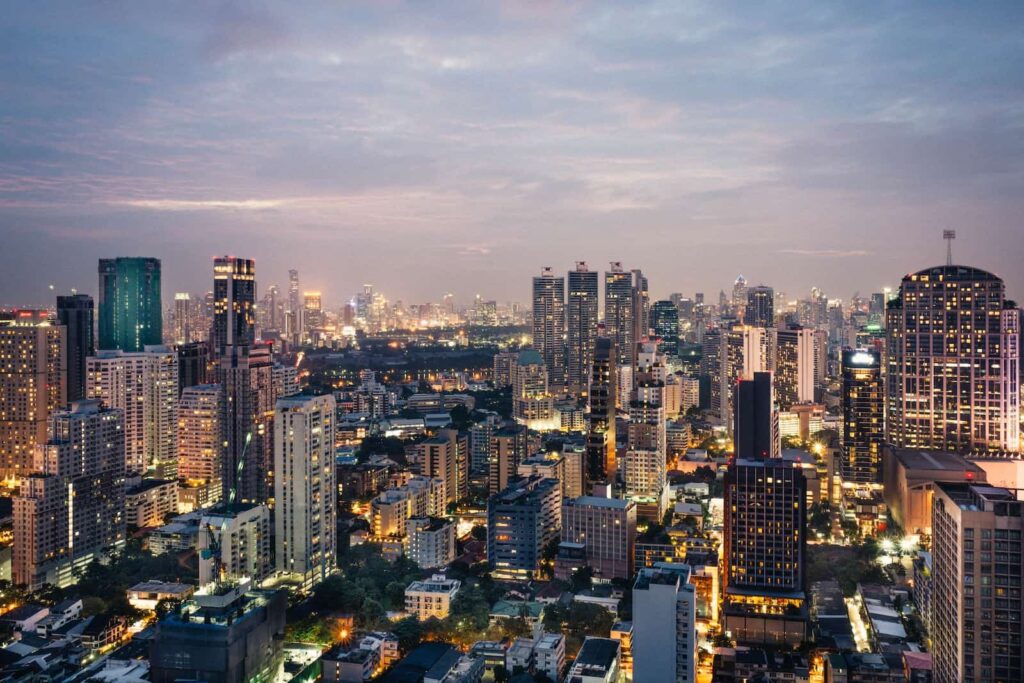
The bustling metropolitan capital city with an abundance of food, culture and nightlife.
Free Thailand Advice
Thailand guides.
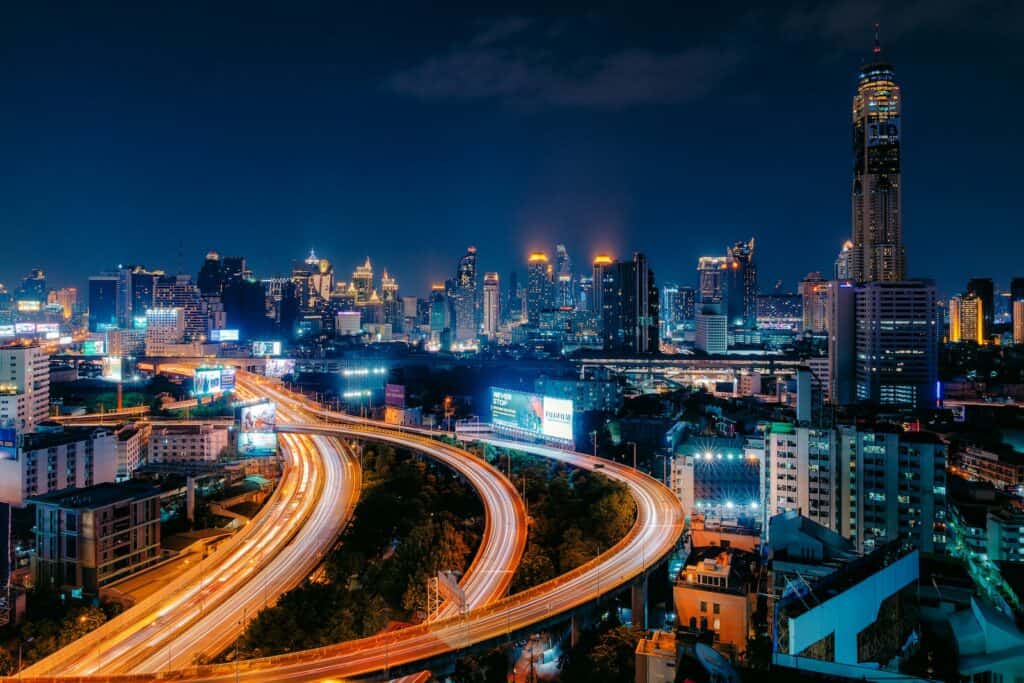
Cheap Hotels in Bangkok
January 15, 2023
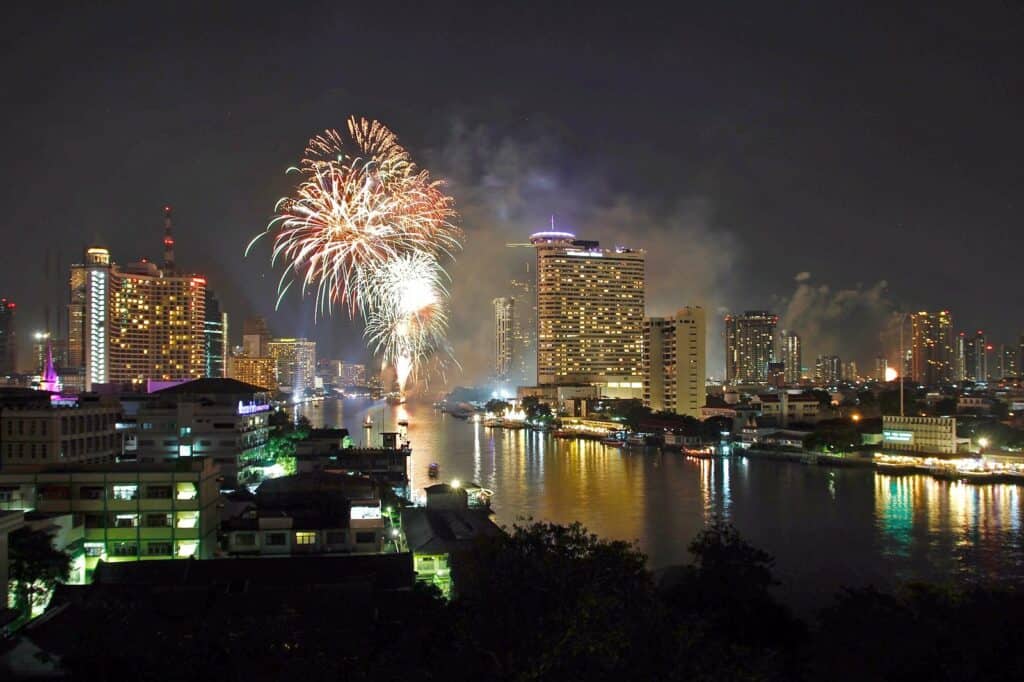
New Years Eve in Bangkok: Tips and Advice for NYE 2024
November 22, 2022
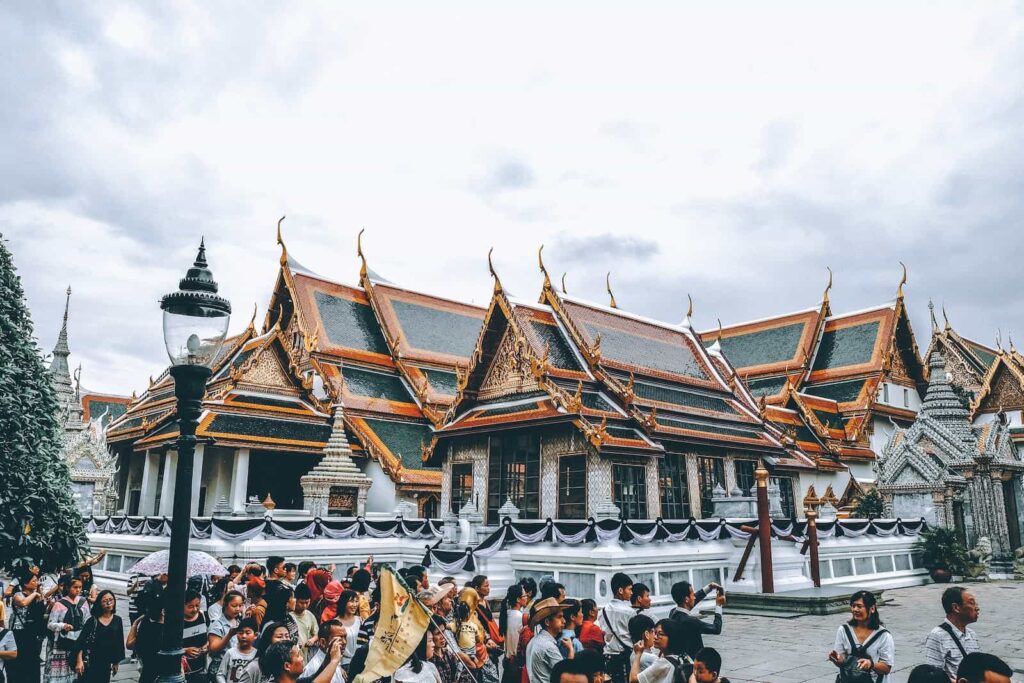
10 Things To Do in Bangkok
September 10, 2022
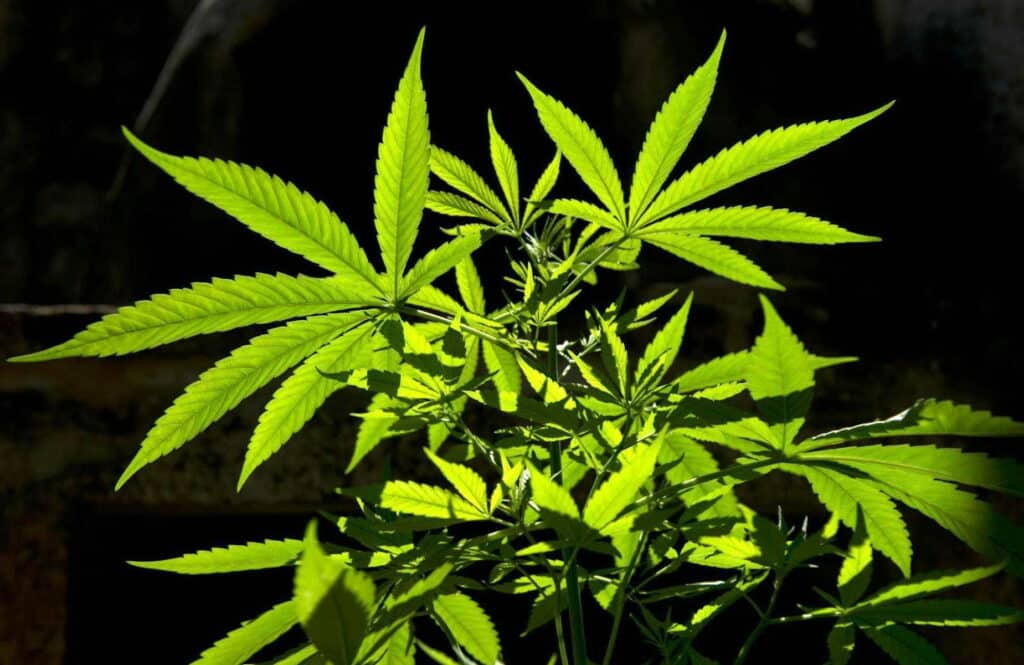
Cannabis in Thailand: What You Need to Know
February 4, 2023

Discover the Ancient Art of Sak Yant Tattooing in Thailand
January 17, 2023
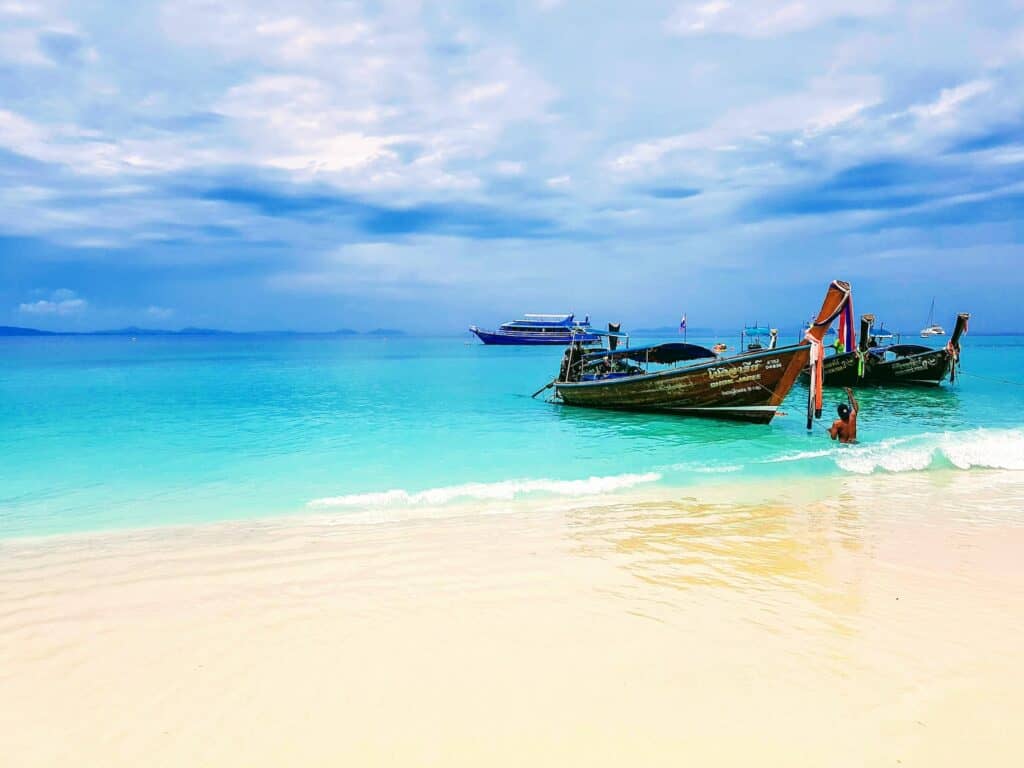
Planning a Trip to Phuket? Know the Weather Before You Go!
January 14, 2023
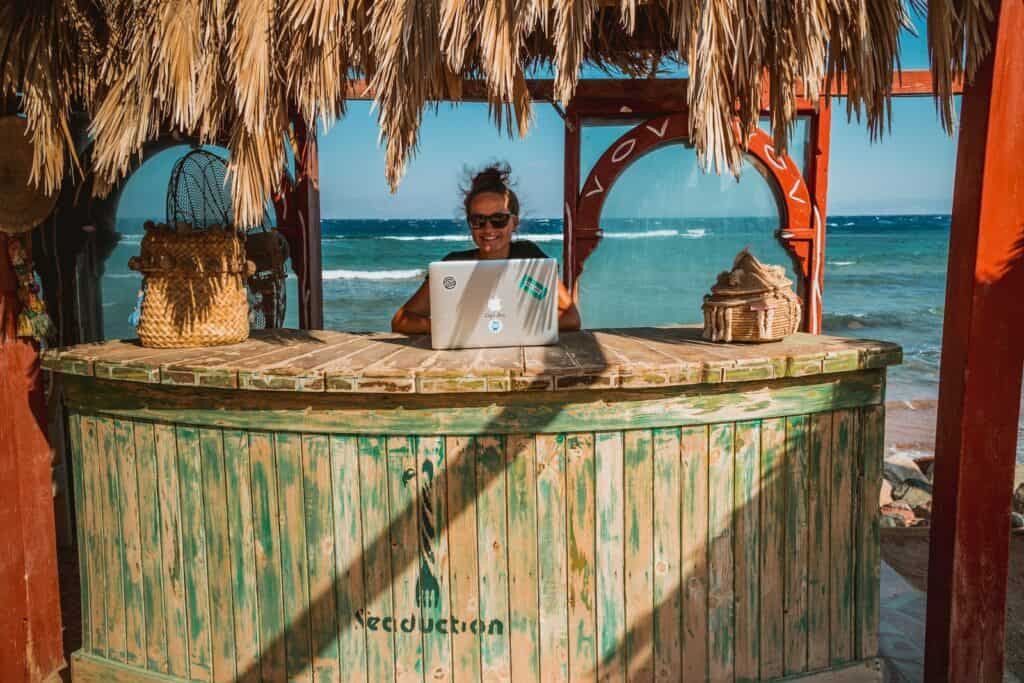
Digital Nomads in Thailand: A Guide for Working Remotely in Paradise
January 4, 2023
Your Thailand Holiday Toolkit
There is a whole universe of special deals, offers and travel advice online. We recommend the following websites and resources to help in planning your perfect trip to Thailand.
For Flights:
- Skyscanner is always our starting point when searching for domestic and international flights. See all the options in one place with easy options to book.
For Hotels:
- Booking.com is the most popular booking site for both tourists and locals here in Thailand. You can typically find the best deals here and accommodation is often much cheaper than the walk-in rate.
- Agoda is another hugely popular option for finding accommodation in Thailand.
For Things to Do:
- GetYourGuide has a wide range of activities, adventures and trips available for instant booking.
For Buses, Boats and Other Transfers :
- 12Go is invaluable and gives up-to-date information on timetables and transfers, especially useful when travelling to the islands.
For Travel Insurance :
- World Nomads is a long-trusted, very popular option.
- Safety Wing is a popular choice for longer-term digital nomads with a very simple subscription model.
Airport Transfer
Things to do.
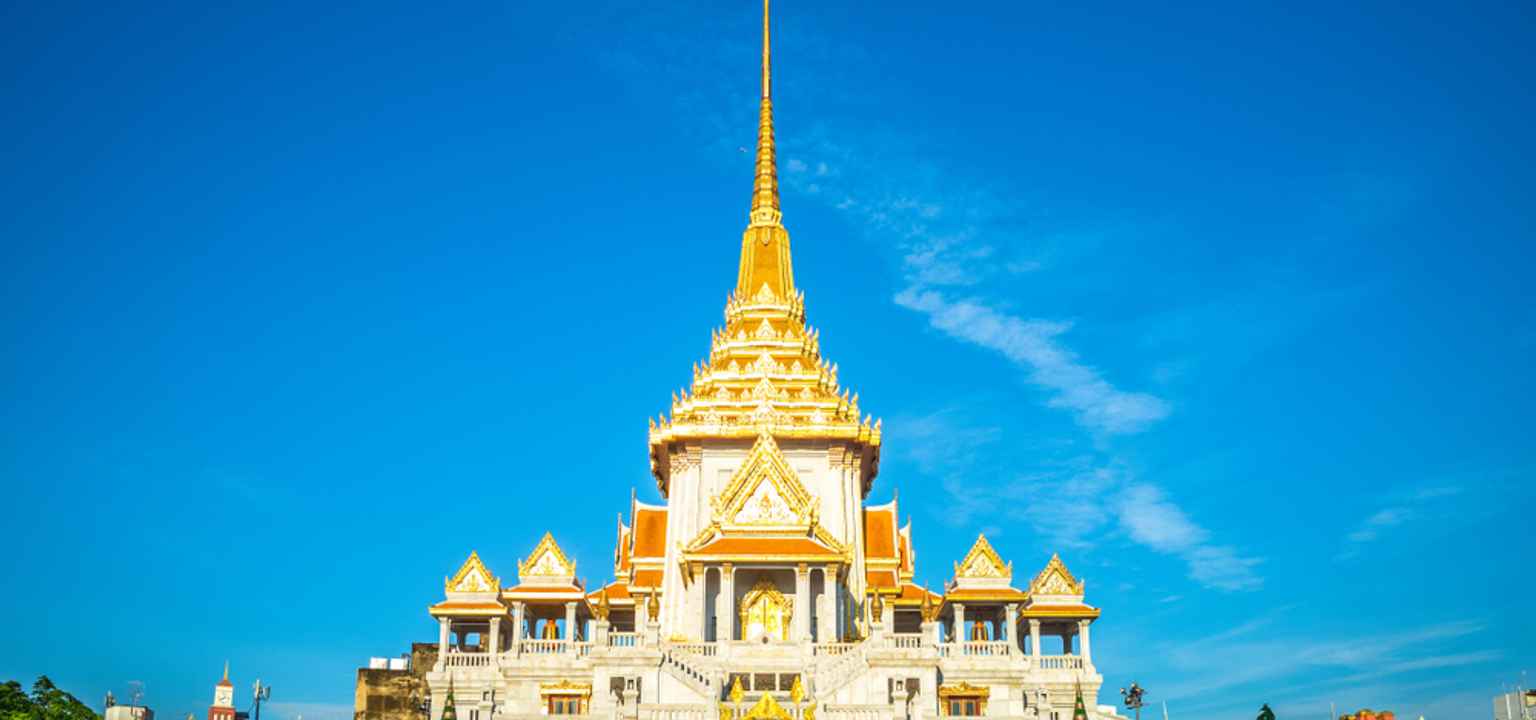
Traveloka Team
17 Jan 2024 - 4 min read
Must-Know Before Going to Bangkok! A Full Guide to Using the BTS Skytrain to Travel Around Bangkok on a Budget
If you're gearing up for a budget-friendly exploration of Bangkok, you must know this game-changer—the Bangkok BTS Skytrain. Navigating around the city becomes a breeze on this efficient and affordable public transport.
Imagine cruising past Bangkok's iconic skyline, hassle-free and light on the wallet. Intrigued? Let’s join us on a journey through the ins and outs of the Bangkok BTS—from its routes to pocket-friendly fares. Trust me, you don't want to miss out on this local gem.
Ready to uncover the secrets of seamless city exploration? Read on to learn more about BTS Skytrain for your next smooth trip in Bangkok!
Are Bangkok MRT and BTS Different?
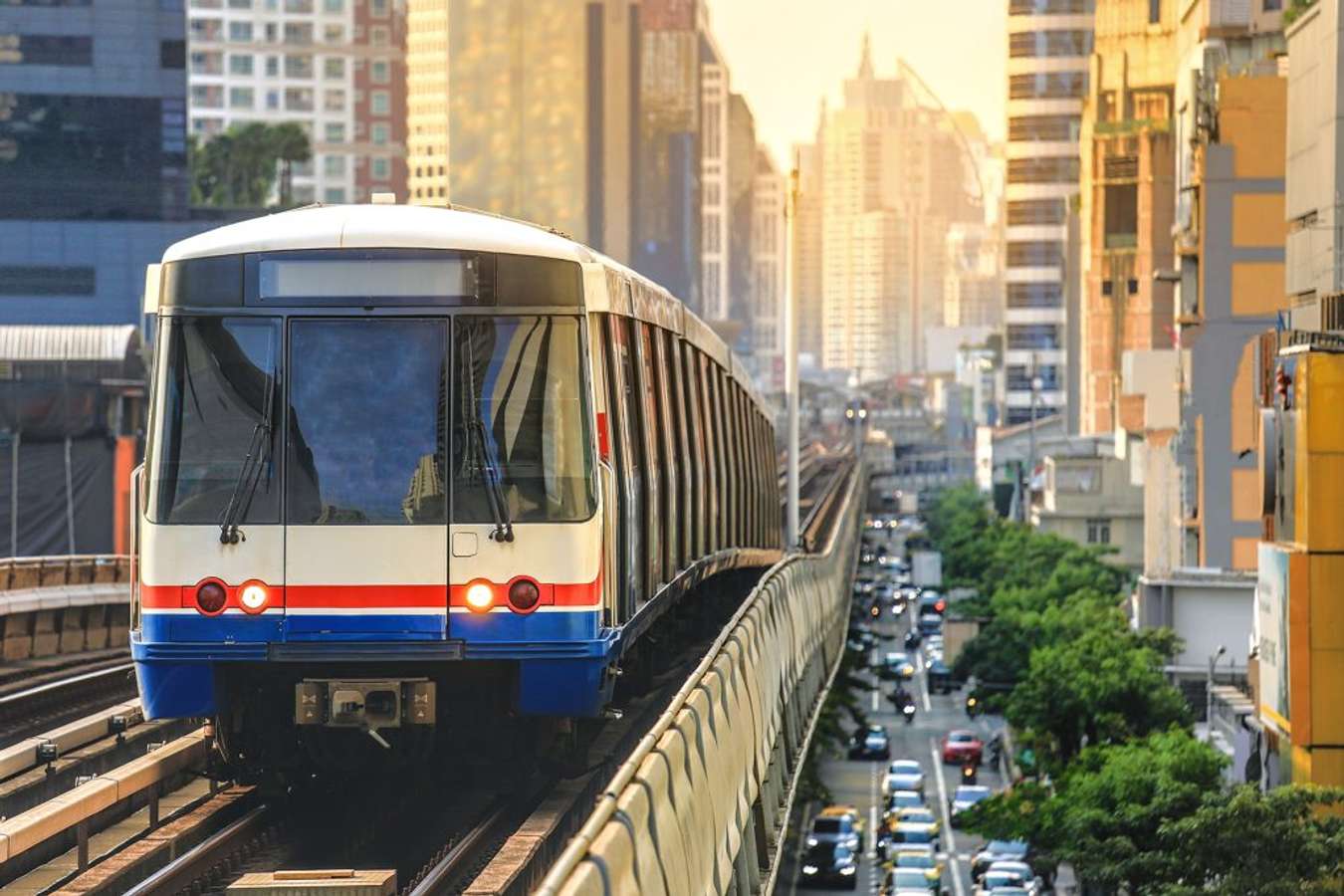
Bangkok has several public transportation alternatives, but MRT (Mass Rapid Transit) and BTS (Bangkok Mass Transit) Skytrain are two of the most convenient ways to travel around the city. What are the differences between those two?
The primary difference between these mass transit systems is their tracks. While MRT mostly runs underground, BTS runs along elevated lines. On top of that, the BTS system consists of 62 stations with 70.05 kilometres of system length, while there are 54 stations for MRT with 225.7 kilometres of system length.
However, both offer clean trains with comfy chairs and air-conditioned systems, ensuring your trip around Bangkok is pleasant despite its hot, humid weather.
If you’re travelling from abroad or from other cities, don’t worry about getting lost since there are travel help desks ready to give you guidance and advice for essential travel things in Bangkok, including tour service, itinerary, and travel destinations.
Bangkok BTS Skytrain Route
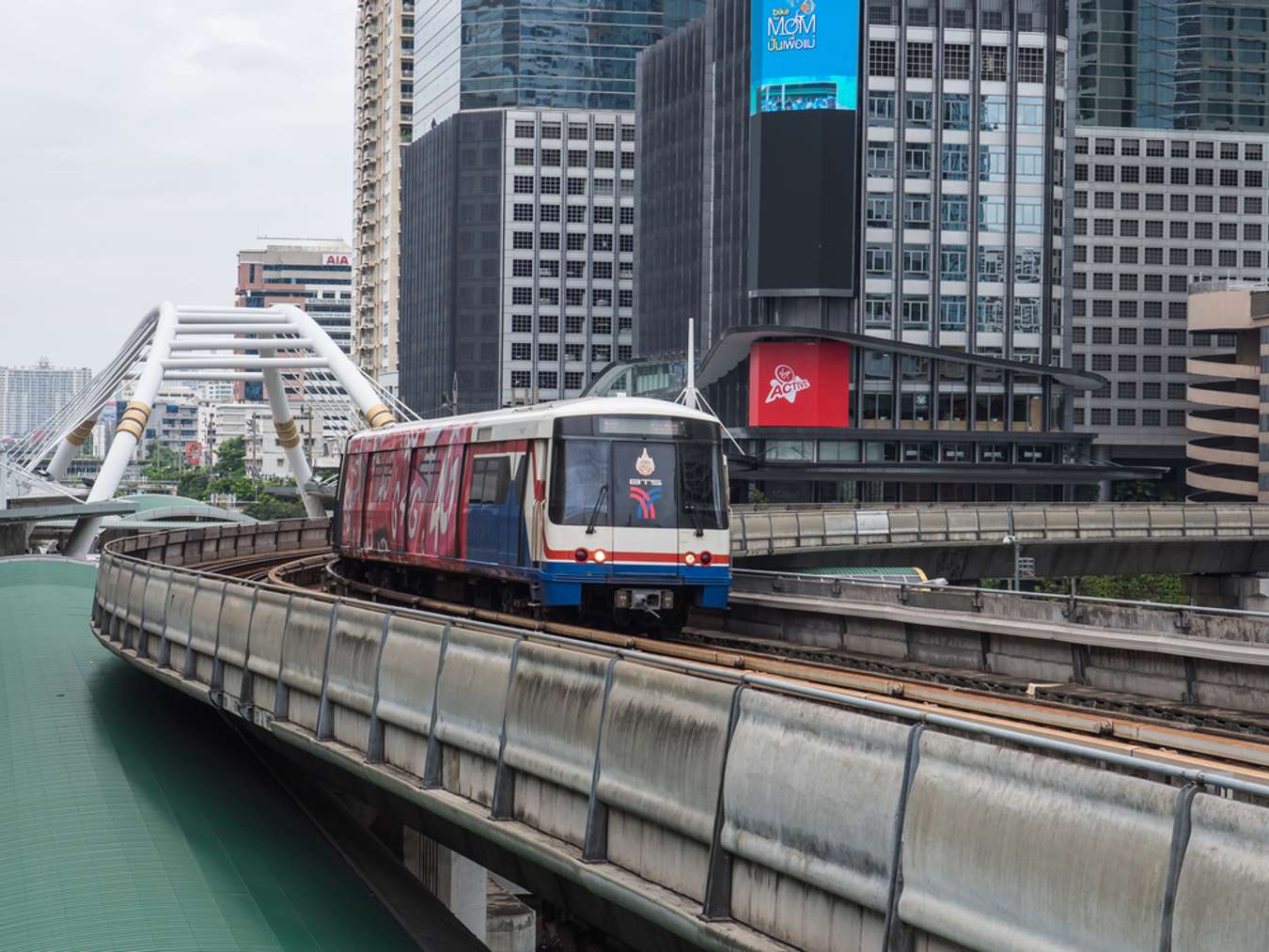
Bangkok has two BTS Skytrain lines: the Sukhumvit Line and the Silom Line.
1. The Sukhumvit Line
The Sukhumvit Line starts at Kheha Samutprakan Station and ends at Khu Khot Station, covering three provinces: Pathum Thani, Bangkok, and Samut Prakan. The system length is approximately 54.25 kilometres, and 47 stations, including Siam, the only interchange station, are included.
This route crosses several stations near famous tourist attractions, such as Victory Monument BTS Station, a 4-minute walk from the Victory Monument.
Another popular tourist attraction along the BTS Sukhumvit Line is SEA LIFE Bangkok , a 13-minute drive from the BTS Skytrain Siam station.
2. The Silom Line
On the other hand, the Silom Line starts at Bang Wa Station and ends at National Stadium Station. The total system length is approximately 14 kilometres, with 14 stations and two interchange stations: Siam and Saint Louis Station.
Arriving at Saphan Taksin BTS Station, you can drive 8 minutes away to Chao Phraya Princess Dinner to set sail and enjoy a first-class dinner cruise for a 2-hour voyage along the river. From the cruise, you can witness the stunning Grand Palace and the Temple of Dawn from afar.
By the end of the Silom Line route, you’ll be near Thailand’s infamous National Stadium, situated only a 7-minute walk from the National Stadium BTS Station.
Recommendation of Hotels Near Bangkok BTS Skytrain Route
1. de prime rangnam hotel.
Address: 106/19 Rang Nam Alley, Thanon Phaya Thai, Ratchathewi, Bangkok 10400, Thailand
Price: Starts from THB 1,634.42
Conveniently situated in central Bangkok, a 9-minute walk from BTS Victory Monument station, De Prime Rangnam Hotel provides a 4-star experience.
Moreover, it is minutes away from King Power, the city's largest duty-free shopping mall, surrounded by smaller malls and lively street food stalls, capturing the essence of everyday Bangkok life. On top of that, there is an outdoor pool, a restaurant, and a bar for a well-rounded stay.
2. Boutique Poo-Yai Lee @BP Place
Address: 5 Phaholyothin Soi 18, Phaholyothin Road, Jompol, Chatuchak, Bangkok, Chom Phon, Chatuchak, Bangkok, Thailand, 10900
Price: Starts from THB 1,562.64
Located just a short stroll from Chatuchak Weekend Market and a 10-minute walk from Saphan Khwai BTS Station, Boutique Poo-Yai Lee presents cosy air-conditioned rooms with balconies and complimentary Wi-Fi.
It's an ideal choice with its proximity to the Central Ladprao Department Store and easy access to Don Muang and Suvarnabhumi Airports.
Bangkok BTS Skytrain Fare
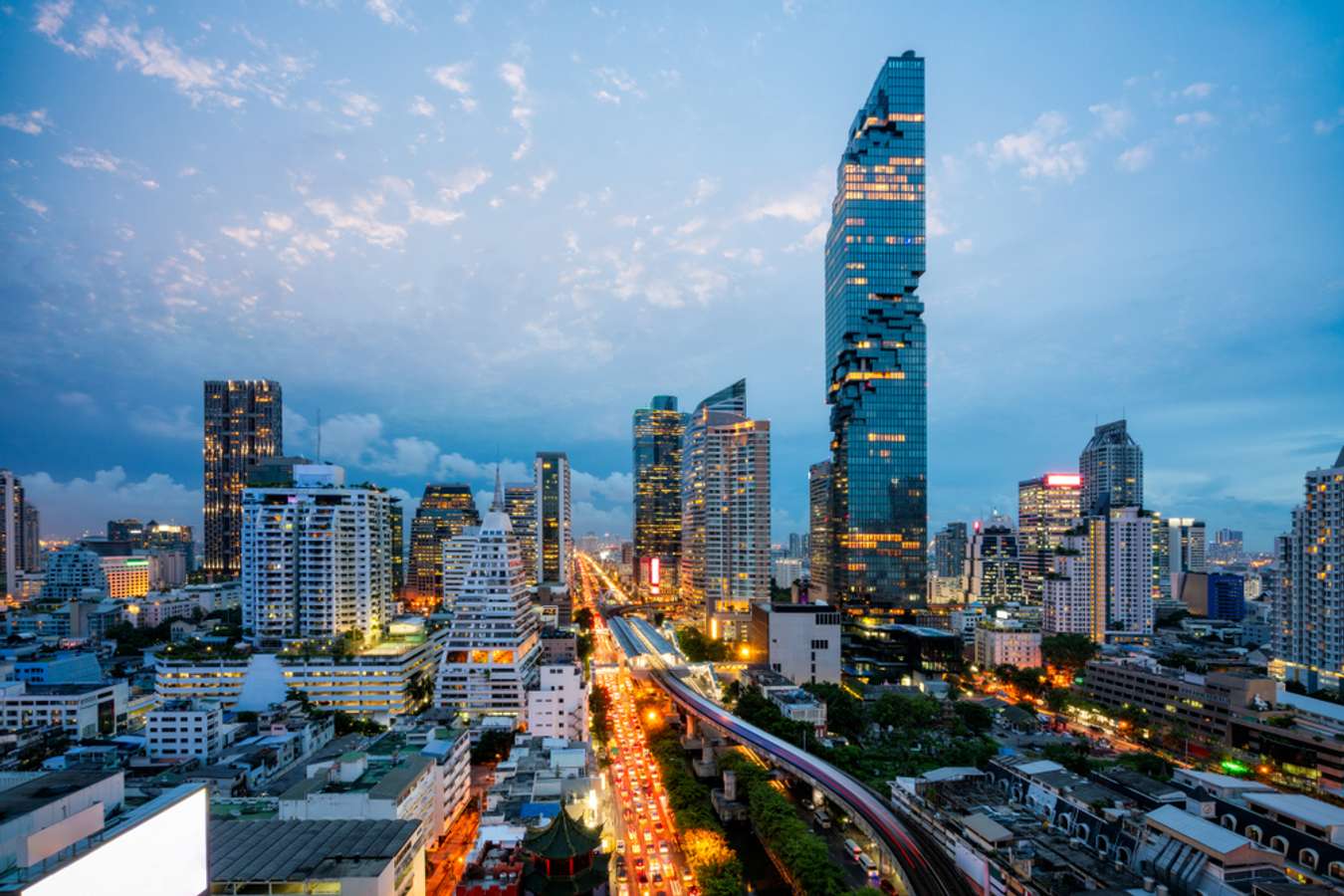
The BTS Skytrain offers a cost-effective and efficient transportation solution in Bangkok, with fares ranging from THB 17 for one station to THB 47 for eight or more stations.
For added convenience, you can use the general Bangkok BTS SkyTrain Rabbit Card. This card allows seamless travel without the hassle of individual ticket purchases. With a variety of recharge options, the Rabbit Card ensures swift entry, saving time at ticket vending machines.
Priced at THB 200, including a THB 100 card issuance fee and initial charge, the Rabbit Card comes with a 5-year validity period and a 2-year validity for the top-up amount.
Beyond BTS, the Rabbit Card extends its usability to popular eateries and shops in Bangkok, offering discounts for seniors and students. Note that BTS tickets are not interchangeable with other public transport systems in Bangkok, such as the MRT.
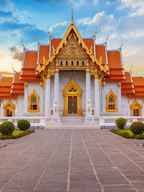
Those are important points to note about BTS Skytrain before visiting Bangkok for your next travel itinerary. Elevate your trip by planning with Traveloka—your one-stop app for booking hotels and flights to Bangkok with the best deals. Book your flight tickets with Traveloka now and step aborad on a memorable journey in Bangkok!
Book Your Flight to Bangkok Now!

Jetstar Asia Airways
Start from S$ 113.10
Singapore (SIN) to Bangkok (BKK)
Tue, 14 May 2024

Malaysia Airlines
Start from S$ 193.20
Fri, 3 May 2024

Start from S$ 209.15
Tue, 30 Apr 2024
Payment Partners
About Traveloka
- How to Book
- Help Center
Follow us on
- Airport Transport
- Traveloka Affiliate
- Privacy Notice
- Terms & Conditions
- Register Your Accommodation
- Register Your Experience Business
- Traveloka Press Room
Download Traveloka App
An official website of the United States government Here's how you know
Official websites use .gov A .gov website belongs to an official government organization in the United States.
Secure .gov websites use HTTPS A lock ( Lock A locked padlock ) or https:// means youâve safely connected to the .gov website. Share sensitive information only on official, secure websites.
Site Notification

Ticket prices and travelcards
Fares for Moscow's public transport network are the same for every mode of transport making it really easy to travel. See all the different tickets here !
Troika Ticket
This is the most economical option if you're spending a few days in the Russian capital. The card can be purchased and recharged at various station machines or even with the special Moscow Metro application. Your balance can be checked on the app or in the small yellow terminals inside the metro stations. A trip works out at ₽ 42 ( US$ 0.40), but if you change transport within 90 minutes, you'll only pay ₽ 23 ( US$ 0.20) for the next trip.
The day ticket for the Moscow metro can be purchased at any of the stops in the city. The price is ₽ 265 ( US$ 2.80) per day and ₽ 500 ( US$ 5.30) for three days.
90-Minute Ticket
The most convenient card if you want to take several types of transport within an hour and a half period. It costs ₽ 65 ( US$ 0.70) per person and allows one metro ride and an unlimited number of trips on other types of public transport in Moscow during the time of its duration.
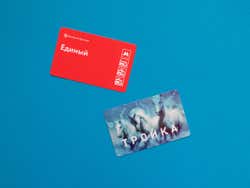
You may also be interested in
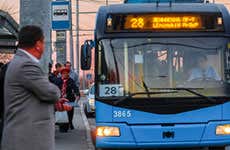
Moscow's crazy traffic and its excellent metro network mean that the city's buses and trolleybuses aren't the number one option for tourists.
Where to stay
Moscow has a wide range of accommodation: find the perfect district for you and book hotels, hostels and apartments at the best possible price.
Android Police
9 simple google flights tips and tricks to try on your next trip.
Snag sweet travel deals with Google's flight search platform
Google Flights is among the best apps for cheap travel . It's the one-stop search engine for airplane trips and consolidates hundreds of top online travel agencies (OTAs). You can search for the best ones in a central hub from your mobile phone or personal computer . You won't have to visit multiple websites, and you can find anything based on round or multi-city trip entries and other criteria. Flights also has tools for cost comparison, so you can see whether current prices are high compared to historical data. Here's how to save money and reach your desired locations quickly.
1 Use the price comparison tool
Google Flights has a date grid that displays departure and return dates around your selected travel dates. Dates with the lowest prices indicate the figures in green. Those in red indicate higher-than-usual prices. Use the grid to make comparisons and find the best rates for your budget.
The price graph shows a visual representation of flight patterns. You'll identify optimal times to fly based on pricing trends. You can even view the full price history for a route up to 60 days before the current date. Here's how to use these features:
1. On your browser, visit google.com/travel/flights .
2. Enter your location and destination. Then click Search .
3. Click Date grid to make price comparisons.
4. Select Price graph to view fare trends by month or week.
How to easily pack your electronics for travel
2 explore affordable travel options.
The Google Flights search tools help you find available and affordable airlines. Typically, you'll enter your location and destination in the search fields. This function only brings flight results along the route you selected. If you leave the destination field blank, Flights shows a map in the Explore tab . You can pan it for airlines with the best fares.
If your travel plans are flexible, you could save on flights by considering alternative travel dates. Flights automatically sets a sample trip duration lasting for a week and within the next six months. This default date range might not give you the best deals. Click the sample date, or use the search fields on the left sidebar to adjust dates according to your preferences.
3 Get inspiration on what to do
The Explore tab is where Google Flights shows airlines, prices, and available flights. You can also use it for inspiration when planning your schedule. Clicking a destination on the map shows places to see in the left sidebar. You can also find hotels and vacation rentals if you don't have accommodation.
The sidebar also shows peak and off seasons to help you determine the best time to visit a place. This way, you avoid travel disasters when there's too much population, bad weather, and other factors. People often ask questions about locations on Google Search. Explore pulls the ones related to a place, allowing you to expand them quickly without running a separate search.
4 Search and book multi-city trips
Searching for destinations and booking repeatedly on Google Flights is stressful. The platform allows you to perform multi-city searches simultaneously. Plus, you can make broader comparisons between fares and save money on international trips.
Instead of booking separate one-way flights, you'll book multi-city flights as a single unit with supported airlines or separately. Here's how to use the feature:
1. Go to the Google Flights website .
2. Click Round trip . Then, select Multi-city .
3. Click Add flight to insert more fields. Then, enter where you're flying from and where to in each of them.
4. Enter the departure dates. Then, click Search . The platform provides results for all available flights in your selected regions.
5 Automatic price guarantee
Price guarantee helps you secure the best prices for your flights. The feature is available for flights with charges that Google has assurance of before it takes off. If you turn on the feature for a booked flight, Google monitors the rates until you board and gives you a refund if it turns out cheaper than originally displayed.
However, the price difference must exceed $5 to qualify for a payout. Also, you can only receive a maximum payout of $500 per Google account within a year. The feature works for trips you book on Google Flights, as well as those you discover on the platform but eventually book on the airline's website.
Price Guarantee is a pilot program and is still under testing. Not all flights are eligible for it until Google expands it. Eligible flights have a colored badge near them. Click a checkbox when booking to activate the feature.
How to plan a road trip with an electric vehicle
6 set fare alerts.
While Google Flights does its best to save your money, airline fares can change at any time. Price surges usually happen closer to departure dates because fewer seats are available. Airlines try to capitalize on travelers' willingness to pay for the remaining ones. Other times, pricing drops or remains stable when fewer travelers book flights.
You can set alerts to monitor these changes for specific routes on Flights. You'll receive automatic notifications via email. It saves you from constantly checking the prices yourself. Here's how to do it:
1. On the Google Flights website, enter your departure point and destination.
2. Set your departure and return dates.
3. Click Search .
4. Turn on the toggle switch beside Track prices . Flights sends you email notifications when travel fares change for your route within the specified dates.
7 Confirm ghosting prices
Ghosting prices refer to situations where you spot attractive flight fares. When you try to book them, the price jumps or becomes unavailable. There's an explanation for it. Google Flights is a flight search engine, not a booking platform. Even though it provides booking buttons and options, all links lead you to book with airlines or online travel agencies.
When you experience ghosting dates, airlines have updated their prices. However, there's a slight delay before Google Flights receives the information. Double-check the airline's website or contact them. You may still be able to access the ghosting prices.
8 Book layover flights
Layover flights are connecting air trips that include one or more stops between your starting point and destination. They are often cheaper than nonstop flights for the same route. Airlines usually have hubs or stop points for travelers going to various destinations.
If you're flexible with your travel plans, booking two separate flights – one from Point A to the layover city and another from the layover city to Point B – can be cheaper than booking a direct flight. However, it will take longer to reach your destination.
Google Flights has a handy layover duration feature. It tells you how long you'll wait at the airport before boarding your next flight to your final destination. Use this tool to filter the shortest route for you. Follow the steps below to start:
1. On the Flights page, click the Connecting airports search filter.
2. Use the slider to adjust your preferred layover duration.
3. Select your preferred airports. The platform shows the results.
9 Change your currency, language, or location on Google Flights
Google Flights typically sets the search currency, location, and language to match your IP address. If you're in the United States, you'll see prices in dollars. But it may be wrong. There are buttons beneath the menus and web pages for changing your language, country, and currency. You can also access the buttons on the platform's menu. Here's how to use both methods:
1. On the Google Flights website, scroll down to the bottom of the web page.
2. Click the Language , Country , and Currency options to adjust the settings to your preferences.
3. Alternatively, click the menu icon in the upper-left corner. Then, use the corresponding options.
How to pair earbuds or AirPods to a plane's seatback entertainment system
Use google flights to save on your next trip.
Google Flights finds flights well, but that's where its efforts stop. You'll need trip-planning features to enhance your experience. You'll find them in other dedicated travel apps , like itinerary building, budgeting, activity recommendations, and offline access. Some apps help you find accomodations and help you pack. Download them for free on the Google Play Store.
Check in Price
Travel Economics for Expats and Travelers
Moscow Airport to City Centre: Bus, Metro and Train
Let’s learn how to travel from moscow airport to the city centre by train, bus, metro and taxi, and comparing prices and journey times using each one of these options.
Are you traveling to Moscow by plane and not sure how to travel to main areas of the city? Check our guide below and compare the best options to travel from Moscow Airport to the city centre .

Moscow Airports: Overview
The first thing you should consider when flying to Moscow is to find out at which airport you will arrive. The capital of Russia currently has four airports operating domestic and international flights, and each airport has its peculiarities. The four airports for civilian traffic in Moscow are: Sheremetyevo (IATA: SVO), Domodedovo (IATA: DME), Vnukovo (IATA: VKO) and Zhukovsky (IATA: ZIA).
Depending on the airline and the route, you will arrive in one of these airports in Moscow. Currently all of them have international connections. Sheremetyevo is currently the biggest airport in Moscow in passenger traffic, but Domodedovo is almost as big as it.
If you haven’t been to Moscow, the most central area of the city is close to the Red Square and the Arbat Street. Check more information in our guide of the best places to stay in Moscow .
Moscow Airport to City Centre
As mentioned above, Moscow has four airports operating domestic and international routes. Below, we will have a brief overview about each one of these airports followed by the options to get from each of these Moscow Airports to the city center.
Moscow Domodedovo International Airport
The Moscow Domodedovo International Airport is the second biggest in Moscow in terms of passenger traffic, and a hub for a number of major airlines in Russia. It is located 42 kilometers South of Moscow’s center, and it is the only privately owned airport serving the city.
Moscow Vnukovo International Airport
Moscow Vnukovo is the oldest airport in the Russian capital, among the ones in operation. Its location is 28 km Southwest of the city center. Vnukovo is the third airport in Russia in terms of traffic, and receives domestic and international flights from companies like Aeroflot, Pobeda, UTair and Wizz Air.
Moscow Zhukovsky International Airport
Moscow Zhukovsky International Airport is the fourth busiest in Moscow, and considerably smaller than the other airports serving the city. However, it receives both domestic and international flights, and Ural Airlines is one of its main operators. It is located 36 km Southeast of Moscow.
Express Train (Aeroexpress)
There is a network of express trains connecting Moscow airports to the city center, and they are called Aeroexpress . They connect the following Moscow airports to the city center: Sheremetyevo, Domodedovo and Vnukovo. If you are going to the Zhukovsky airport there is no Aeroexpress service, however, other trains go to this airport.
Aeroexpress from / to Sheremetyevo Airport
In the case of Sheremetyevo, the Aeroexpress connects the airport to the Belorussky Railway Station. From the Belorussky Station you can easily get around Moscow city centre using the metro line. The metro station serving this station is called Belorusskaya, with the metro lines 2 and 5.
Aeroexpress from / to Domodedovo Airport
From Domodedovo to the city center, the direct Aeroexpress will take you to the Moscow Paveletsky station. You can from there connect with the metro lines number 2 and 6 (Paveletskaya Station) as well as buses and trains.
Aeroexpress from / to Vnukovo Airport
From Vnukovo Airport the Aeroexpress will take you directly to the Moscow Kievsky Railway station. From there you have three metro lines to choose from, all at the Kiyevskaya Metro Station.
Aeroexpress Information
In most cases, I would recommend choosing the Aeroexpress to get from Moscow Airport to the city centre. Even if it is not the cheapest option, it is the most convenient, and often the fastest. The ticket costs 500 RUB (one way – standard fare) and can be bought on stop as well as online on the Aeroexpress website.
The Aeroexpress usually operates each 30 minutes (or one hour), from early in the morning until late, which makes of it very convenient. You also take it from inside the Airport building, in a relative short walk, regardless of which terminal you arrive. The frequencies depend on which airport you are traveling from and the time of the day.
Train from / to Zhukovsky Airport
Even if the Zhukovsky Airport is not served by the Aeroexpress, it is possible to travel from this airport to Moscow city centre by train. You can take the Sputnik train from the Kazansky Railway Station to the Otdyh Station, and from there a Shuttle Bus to the Airport terminal.
However, if you are going or coming from the Zhukovsky Airport, I consider the bus and metro a better option.

Car Rental and Airport Transfers
You can also rent a car and pick it up directly at the airport. This is especially a good idea if you will stay in Russia for more than a few days and will visit other cities than Moscow. Click to compare car rental prices in Moscow on RentalCars .
Another option is getting a transfer organized before hand. The transfer has a good advantage over the taxi, as it will be waiting for you as you arrive, and you can pay before hand online. You can book a Moscow Airport transfer online here .
Other Resources for Traveling in Russia
If you are traveling to Russia you might want to check some of our other guides to the country. Check where to stay in Moscow and the best places to stay in Saint Petersburg .
- Newsletters
- Account Activating this button will toggle the display of additional content Account Sign out
The Lost Art of Steamship Gossip
Passenger lists used to offer a voyage full of salacious chin-wagging. we could use some of that energy today..
When the British journalist Don Iddon boarded the S.S. United States in 1954, his first act was to locate a copy of the boat’s first-class passenger list. As he read it, his heart sank —sure, Harry Truman’s daughter, Margaret Truman, was on board, and so were a few prominent businesspeople. But the list, as he wrote later and Steven Ujifusa recounts in the book Seductive Journey: American Tourists in France From Jefferson to the Jazz Age , contained a distinct lack of “big names.” Where were all the movie stars?
With the rise of steamship travel in the 19 th century and into the 20 th century, passenger lists were a central feature of any long voyage—a prized preview among passengers of the kinds of people with whom they’d be rubbing shoulders throughout their journey. Lorraine Coons, a historian who wrote a book on steamship travel, told me that in her research she first notices them popping up around the 1880s. These lists, often color-coded by cabin class, were handed out to new arrivals, who invariably scoured them for names of celebrities. It didn’t matter whether your reputation was favorable or in disgrace—anyone with a high profile would make for good entertainment during the voyage. Journalists obtained copies too: When ships departed from port cities, local reporters ran articles listing out all of the most famous names on board.
What made these lists so unique is the sheer transparency they offered. Royals, politicians, and A-list celebrities were named alongside regular midtier passengers, a rare blending of social classes that, in 1910, prompted one writer to bemoan, “The very best people are set down cheek-by-jowl with the nobodies.” But that accessibility was also the beauty of the passenger list. There was no loophole for the richest travelers: If you wanted to ride on the boat, you had to be on the passenger list.
Today we no longer really have a comparison—those cryptic, initialed upgrade monitors at the terminal gate don’t quite scratch the same itch. On airplanes, travelers are reduced to shuffling through first class while trying to surreptitiously spot a famous face. Increasingly, even that has become difficult, as celebrities flee to full-scale private suites and terminals before boarding their flights via VIP programs that whisk them to and from the plane. For the truly intrepid, there is one way to track a celebrity’s travel movements, through publicly available private jet flight data—and the likes of Taylor Swift and Elon Musk have attempted to quash it.
Although a return to the officially sanctioned nosiness of the steamship era is unlikely, in today’s hyperstratified world, where the wealthiest can pay for the privilege of privacy, we could probably use a little bit of that social transparency. Those old passenger lists helped puncture, at least briefly, the classed dynamics of travel—offering everyone on board equal access to gossip. There was no harm in a little bit of intrigue about your fellow passengers. And who knows: Maybe getting our hands on a list of names could make an international flight a bit more bearable today. A little speculation about the other high-powered travelers on board could ease the tension at high altitudes, inside what is historically a pressure cooker of resentment.
In the context of a weekslong steamship voyage, it was perhaps inevitable that passenger lists would become objects of careful study. In the early 20 th century, the glamour of an international voyage got travelers only so far. Once passengers were away from shore, one of their great challenges was to stave off boredom. Some ships offered lectures ; others engineered musical bands out of ship staff; the Île de France had a bowling alley. What activities the vessels didn’t offer, passengers often cobbled together for themselves. Steamship travelers organized theater programs, boxing tournaments, or large balls. At night, they blasted dance music from gramophones.
And so gossip became a commodity. Many passengers took to self-publishing their own steamship newspapers, covering the personal histories of those on board. Some ship newspapers published blind items about passengers. The historian Martyn Lyons discovered that in the margins of one surviving copy of the Tamar Times, a reader had hazarded guesses about which traveler each blind item referred to. Analyses of passenger lists often appeared in these newspapers too. On one ship, a passenger published a single-issue newspaper called The Rolly-Poly, which included an analysis of all the passengers on the list: “Of the women, all are wives except 78 who aspire to be.” Even the elite consulted these lists to choreograph their social interactions, lest they accidentally get stuck in a conversation with someone unrefined.
That the lowly passenger list could become a focal point speaks to just how dull these journeys were. Passenger lists were not Wikipedia entries: They were bare-bones documents, generally offering names and nothing more. A few steamship operators, Coons told me, did also list travelers’ place of residence, but most were strictly limited to names. Passengers were forced to spin out the (perhaps embellished) backstories of the celebrities on board by pooling together their own spotty memories.
Despite these limitations, observers found ways to sleuth out the rich and famous. A name preceded by a title like “Baroness” signaled a person of importance, and so would the size of each passenger’s entourage. It wouldn’t be uncommon for a rich person’s name to be listed alongside “two nurses and a governess.” One passenger list, for instance, noted the presence of “J.K. Smith and valet.” The medical professor William Thomas Corlett recounted the feeling of disappointment in the quality of the guests on board a ship he rode—that is, until he consulted the list. Only then did he note with pleasure the presence of “Herr von This and Herr von That,” as he put it, “together with a sprinkling of Barons and a Baroness or two.”
Not every steamship company loved the passenger list. Some devised ways to keep their steamships as exclusive as possible so that passenger details wouldn’t spread to the public. The S.S. Carolina , for instance, did not let passengers book partial journeys , for fear it would bring in middle-class clientele and lead to leaks of the passenger lists. Basically: You had to afford the whole trip, or you couldn’t board.
Yet the passenger lists that did reach the public have, in recent decades, taken on an outsized importance. Genealogists and historians alike now rely on passenger lists to track how people moved across the world. Amateur genealogists on Ancestry.com regularly take advantage of passenger lists to trace their roots. So does our most famous chronicler of family history, Henry Louis Gates Jr. In retrospect, these documents also charted social transformations: It wasn’t uncommon for immigrants to include a new name when boarding a steamship, or for trans passengers to embrace their preferred gender. I thought a lot about passenger lists while researching Zdeněk Koubek, a high-profile Czech athlete who transitioned gender in 1935, for my forthcoming history book The Other Olympians . In 1936, when Koubek was newly living as a man, he visited New York, and he appeared in the passenger list alongside his new gender: “Mr.”
I’ll allow that passenger lists may no longer make sense in our tech-surveillance world, where even a simple series of names would get scraped by algorithms. But I think we’ve lost some sense of camaraderie without them—lost that thrill of unfurling the manifest and wondering what you might find. These lists could impress, or they could disappoint, but they always entertained. In 1901 Mary Lawrence, a wealthy Bostonian, leafed through the first-class passenger list of the steamship Oceanic . She was excited to see the name of Otho Cushing, an illustrator and cartoonist whose work she knew. “Here at last was one interesting fellow traveler,” she wrote in her diary, according to the book Seductive Journey .
Nearly a decade later, however, when she rode the same steamship again, the list was not so colorful. Lawrence was crushed. “There was not a soul on the passenger list that we had ever heard of before,” she complained. Today Lawrence’s certainty that the list was a complete account of the passengers on board is striking. It didn’t seem to occur to her that there could be loopholes for people who could pay, that you could scrub your name from the manifest if you were famous enough. And perhaps those loopholes really didn’t exist. Steamships had classed cabins, sure, but there was no special treatment for celebrities: At sea, everyone was on the list.
Air New Zealand flights to Australia and Pacific receive new fare system

Sarah Pollok
Share this article
Air New Zealand has introduced several changes to fare types. Photo / Greg Bowker
Kiwis travelling on Air New Zealand to Australia and the Pacific Islands can expect more in-flight entertainment, snacks and flexible fares from June, the airline says.
The days of booking a simple Seat+Bag fare on an Air New Zealand flight to Australia or the Pacific Islands will end in June, it says.
Air New Zealand has announced several changes to its short-haul booking options for flights across the ditch and around the Pacific.
Its new offering, named Seats to Suit, simplifies fare options and increases the “essentials” all passengers receive.
The changes were in response to customers’ desire for more choice regarding what they paid for in a ticket, Air NZ general manager short haul Jeremy O’Brien said.
“The new Seats to Suit updates are based on customer feedback and changes our passengers were looking for,” he said, adding the airline was excited to introduce the changes in June.
So, what changes are coming in June?
Seat+Bag discontinued
From June 11, the Seat+Bag option will be replaced with a Seat fare type, which means travellers with no luggage can pay only for their seat, while those who want to check a bag can add one for $30.
In-flight entertainment and snacks for all
With many airlines, a simple seat fare means you get a spot to sit and nothing else, not even water. However, Air NZ’s revamp means all passengers, even simple Seat fare folk, get access to full in-flight entertainment, a snack and tea, coffee, water and juice.
New flexi fares
The fares will now include Worksflexi, Premiumflexi or Businessflexi. When booking these fares, any change fee is waived if a customer wants to alter their booking and only a fare difference is applied. Refundable fares are also available.
On-board food and drink services to change
Because all passengers will get a snack or meal on board, the airline will no longer allow people to buy in-flight bites, but they can still buy drinks. Plus, customers will no longer be able to buy vouchers at the airport for items on board.
New fare types
The new fare types will include: Seat, Theworks, Worksflexi, Premiumeconomy, Premiumflexi, Businesspremier and Businessflexi.
Long-term domestic fares to increase
Meanwhile, in Aotearoa, travel agents have been warned by Air New Zealand to book domestic fares ASAP.
An industry note from the airline said long-term domestic fares on all routes would increase from April 23, so bookings must be ticketed on or before midnight on Monday, April 22.

Latest from Travel

Amsterdam reveals latest severe tactic for tackling mass tourism
The city has rolled out yet another ban which will impact accommodation.

Tourist alert: Common clothing items you shouldn't wear in Europe this year

38,000 Kiwis waiting for passports amid long delays

I've been campervanning throughout NZ. These are the best places to relax

‘Dark delights’ of Great Barrier Island
/ Timetable บัตรโดยสาร -->

FAA lifts temporary ground stop of Alaska Airlines flights after technical issue is resolved
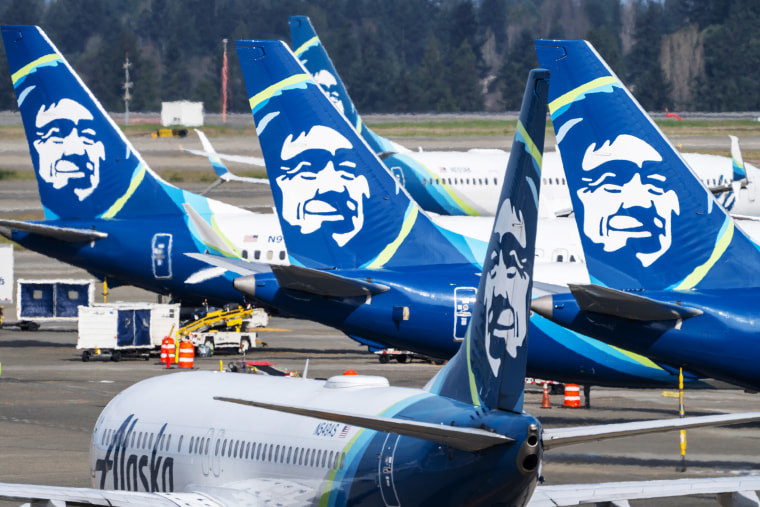
The Federal Aviation Administration lifted a ground stop for all Alaska Airlines flights Wednesday after grounding the planes earlier as a result of a computer problem at the carrier.
The Seattle-based airline said in a statement that an issue arose “while performing an upgrade to the system that calculates our weight and balance.”
The FAA initially approved a ground stop for all Alaska and Horizon flights starting at approximately 10:50 a.m. ET.
It was lifted just before 11:45 a.m. ET.
It wasn't immediately clear how many flights were affected. An Alaska spokesperson did not immediately respond to a request for comment.
Rob Wile is a breaking business news reporter for NBC News Digital.
Jay Blackman is an NBC News producer covering such areas as transportation, space, medical and consumer issues.

IMAGES
VIDEO
COMMENTS
Routes and Fares. Station Places Select Origin : Select Destination : Timetable. Routes. Search for Routes ... BTS Call Center 0 2617 6000 Every day : 06.00 a.m. - 12.00 p.m. Tourist Information Center ...
Find Bangkok BTS fare, map, main stations, operating hours & tips how to use BTS Bangkok. ... Total fare of your trip will show up. Insert coins and/or notes (if the machine accepts them) into dedicated slots. When the amount inserted will reach the required fare, your ticket (thin plastic card) will appear at the ticket-dispensing slot. Take ...
The Bangkok BTS, or Skytrain, is an elevated rapid transit system in Bangkok, Thailand. It consists of two lines, the Sukhumvit Line and the Silom Line. The BTS provides convenient transportation across the city, serving as a reliable and efficient mode of travel for both locals and tourists. With air-conditioned trains and frequent service ...
Bangkok Mass Transit System Public Company Limited. BTS Building, 1000 Phahonyothin Rd., Chomphon, Chatuchak. Bangkok 10900 Thailand. 10900 Tel: 0 2617 7300
The Bangkok Mass Transit System, commonly known as the Skytrain or BTS, is the most efficient means of transportation in in Bangkok. Since 1999 the BTS has been helping Bangkokians and tourists alike hop easily from one station to another. Aside from convenience and speed, fares are cheap compared to other transport modes, and of course fixed ...
The BTS operates from around 6:00 AM to midnight, depending on the station. Trains run frequently, with intervals of 3-7 minutes during peak hours. Tickets: You can purchase single-journey tickets or stored-value cards known as the "Rabbit Card." The fare is distance-based, so the more you pay, the farther you travel.
Fares are adjusted every year or so - usually heading up rather than down. Right now, riding the Skytrain costs from 16 Thai baht (£0.37) for a single ticket to travel one station, up to 59 baht (£1.38) to take in the whole system. A one-day ticket for unlimited travel costs 140 baht (£3.26).
They also sell one-day tickets and Rabbit cards, for which you can ask for assistance. You'll find the exact fare for your destination on the BTS map. Press the corresponding buttons on the machine and insert money. Your ticket will then be dispensed. While entering the station, insert your ticket into the entry gate.
A 15 trip 30 day pass costs 345 Baht, while 25 trips, 40 trips and 50 trips 30 Day Pass costs 525, 760 and 900 Baht respectively. The cards should be used within 45 days from the issue date or after the trips have been last refilled. ... In addition to BTS, this card can also be used for fare payment on the BRT. This is a stored value card and ...
Bangkok bus, MRT (Bangkok Metro), BTS Sky Trains, boats - Chao Phraya Express and Khlong, are collected in one guide. Find information about fares, operating hours, download a Bangkok bus map and view listings. Use Transit Bangkok's route planner to find the optimal route to your destination. How it works: Start writing the name of your origin ...
Tips for Navigating the BTS Bangkok System. With a comprehensive understanding of the BTS map and route planner, navigating the BTS Bangkok system can be easy and enjoyable. However, there are a few additional tips and tricks to keep in mind for a smooth commuting experience: 1. Consider purchasing a Rabbit Card.
The system has a top speed of 80 km/h (50 mph) and carries a daily ridership of over 600,000 passengers. The fares for the BTS are distance-based and range from 15 to 59 baht. To make travel even more convenient, passengers can use the Rabbit Card, a debit card that can be used on the BTS, the MRT, and the Airport Rail Link.
Klook User. 29 Feb. The Bangkok BTS Skytrain's Rabbit Card is a convenient and efficient payment method designed for the city's public transportation system, particularly the BTS Skytrain. This contactless smart card system simplifies travel around Bangkok, allowing users to quickly tap in and out at BTS stations.
Those are important points to note about BTS Skytrain before visiting Bangkok for your next travel itinerary. Elevate your trip by planning with Traveloka—your one-stop app for booking hotels and flights to Bangkok with the best deals. Book your flight tickets with Traveloka now and step aborad on a memorable journey in Bangkok!
Air Fares. Tuesday, April 16, 2024. This page presents inflation-adjusted and unadjusted average air fares since 1995. Averages are computed using data from the Bureau of Transportation Statistics' Passenger Origin and Destination (O&D) Survey, a 10% sample of all airline tickets for U.S. carriers, excluding charter air travel.
National Average. 367.79. 367.79. Source: Bureau of Transportation Statistics, Airline Origin & Destination Survey (10% Sample), DB1B_Ticket where bulk fare equals zero, itinerary fare is greater than or equal to fifty dollars ($50) and itinerary yield is less than or equal to three dollars ($3). Itinerary Fare: Average fares are based on ...
Walking tour around Moscow-City.Thanks for watching!MY GEAR THAT I USEMinimalist Handheld SetupiPhone 11 128GB https://amzn.to/3zfqbboMic for Street https://...
BTS reports average fares based on domestic itinerary fares. Itinerary fares consist of round-trip fares, unless the customer does not purchase a return trip. In that case, the one-way fare is included. Fares are based on the total ticket value, which consists of the price charged by the airlines plus any additional taxes and fees levied by an ...
Routes and Fares. วางแผนการเดินทาง. Travel Information. ข้อมูลการเดินทาง. Price Calculation and Travel Time.
While Moscow has an efficient public transport system, you may sometimes find it more convenient to travel by taxi and prices are usually affordable. Find fares and top tips here! Tickets & travelcards. Fares for Moscow's public transport network are the same for every mode of transport making it really easy to travel. See all the different ...
Your balance can be checked on the app or in the small yellow terminals inside the metro stations. A trip works out at ₽ 42 (US$ 0.40), but if you change transport within 90 minutes, you'll only pay ₽ 23 (US$ 0.20) for the next trip. Day Ticket. The day ticket for the Moscow metro can be purchased at any of the stops in the city.
6 Set fare alerts. While Google Flights does its best to save your money, airline fares can change at any time. Price surges usually happen closer to departure dates because fewer seats are ...
From there you can easily reach the city center. Bus and Metro from / to Sheremetyevo Airport: Buses number 949 and 851 to Rechnoy Vozkal and Buses number 817 and 948 Planernaya Metro Station. Metro from / to Domodedovo Airport: Express bus to the Domodedovskaya Metro Station. Bus and Metro from / to Vnukovo Airport: Bus number 611 to ...
Nearly a decade later, however, when she rode the same steamship again, the list was not so colorful. Lawrence was crushed. "There was not a soul on the passenger list that we had ever heard of ...
American Airlines - Airline tickets and low fares at aa.com
The days of booking a simple Seat+Bag fare on an Air New Zealand flight to Australia or the Pacific Islands will end in June, it says. Air New Zealand has announced several changes to its short ...
Southwest has a summer travel fare sale with fares starting at $49. With summer approaching rapidly, now is the ideal time to start planning some getaways! Flying with Southwest can be a fantastic ...
Bangkok Mass Transit System Public Company Limited. BTS Building, 1000 Phahonyothin Rd., Chomphon, Chatuchak. Bangkok 10900 Thailand. 10900 Tel: 0 2617 7300
FAA lifts temporary ground stop of Alaska Airlines flights after technical issue is resolved. Alaska Airlines said in a statement that it had an issue with the system that calculates the weight ...